The Pacific North-West to Panama
May 1983 to March 1984
The Pacific Northwest
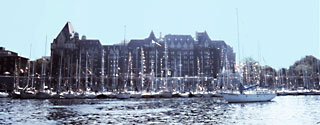 We'd had a very long, hard and cold passage across the North Pacific from Honolulu Hawaii to Victoria, Canada, We arrived on 27 May 1983 after over 2,500 nautical miles (4,600 km) and three weeks at sea in our 37ft sloop, “Cera”. After all that, it was wonderful to be welcomed by the sun as we anchored in the centre of the charming Inner Harbour of Victoria, British Columbia, at the south end of Vancouver Island.
We'd had a very long, hard and cold passage across the North Pacific from Honolulu Hawaii to Victoria, Canada, We arrived on 27 May 1983 after over 2,500 nautical miles (4,600 km) and three weeks at sea in our 37ft sloop, “Cera”. After all that, it was wonderful to be welcomed by the sun as we anchored in the centre of the charming Inner Harbour of Victoria, British Columbia, at the south end of Vancouver Island.
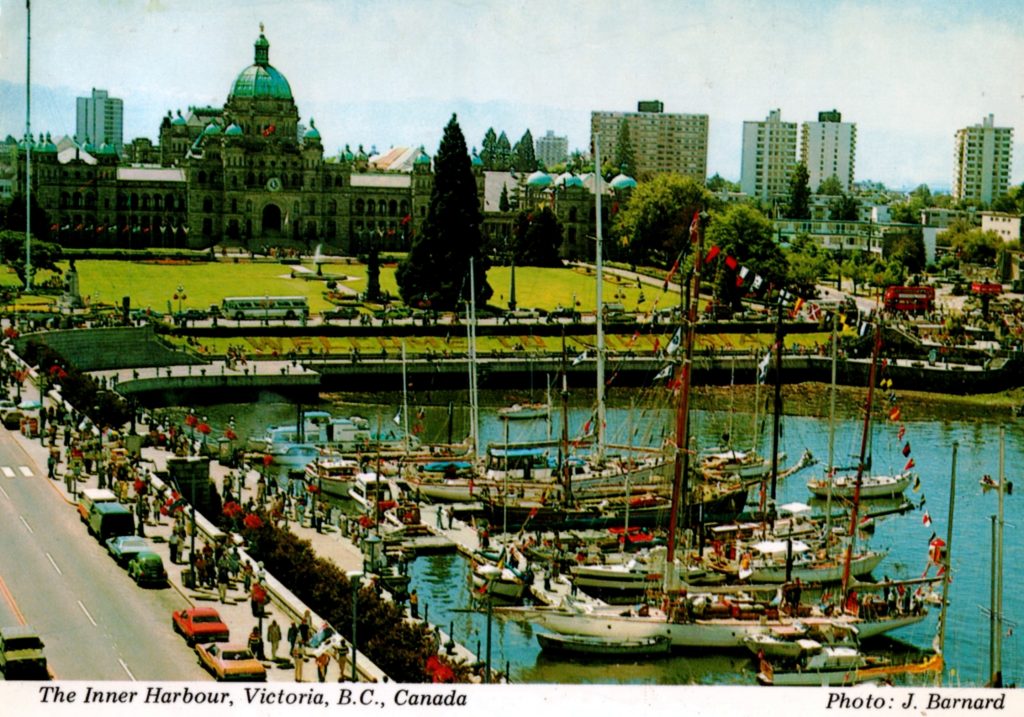 As recounted in previous pages of this account, our arrival coincided with the end of the annual Victoria Harbour festival and with a yacht race - the famous and popular Swiftsure - with 400 entries. As a result,
As recounted in previous pages of this account, our arrival coincided with the end of the annual Victoria Harbour festival and with a yacht race - the famous and popular Swiftsure - with 400 entries. As a result, 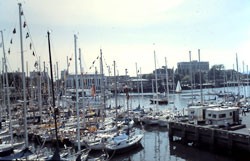 we were treated to harbour-side bands, aerobatic displays, fireworks – and record-breaking high temperatures which had all the locals complaining! Perhaps all we had heard about the cool, wet weather of the Pacific Northwest had been exaggerated? We were to find out, as the weeks went by, that the gloomier forecasts were in fact vindicated, with even the local people conceding that it was a poor summer. However, a side benefit for us was that the absolutely gorgeous, sheltered anchorages of the Gulf Islands, the Strait of Georgia and Desolation Sound were generally uncrowded and peaceful, contrary to expectation and advice.
we were treated to harbour-side bands, aerobatic displays, fireworks – and record-breaking high temperatures which had all the locals complaining! Perhaps all we had heard about the cool, wet weather of the Pacific Northwest had been exaggerated? We were to find out, as the weeks went by, that the gloomier forecasts were in fact vindicated, with even the local people conceding that it was a poor summer. However, a side benefit for us was that the absolutely gorgeous, sheltered anchorages of the Gulf Islands, the Strait of Georgia and Desolation Sound were generally uncrowded and peaceful, contrary to expectation and advice.
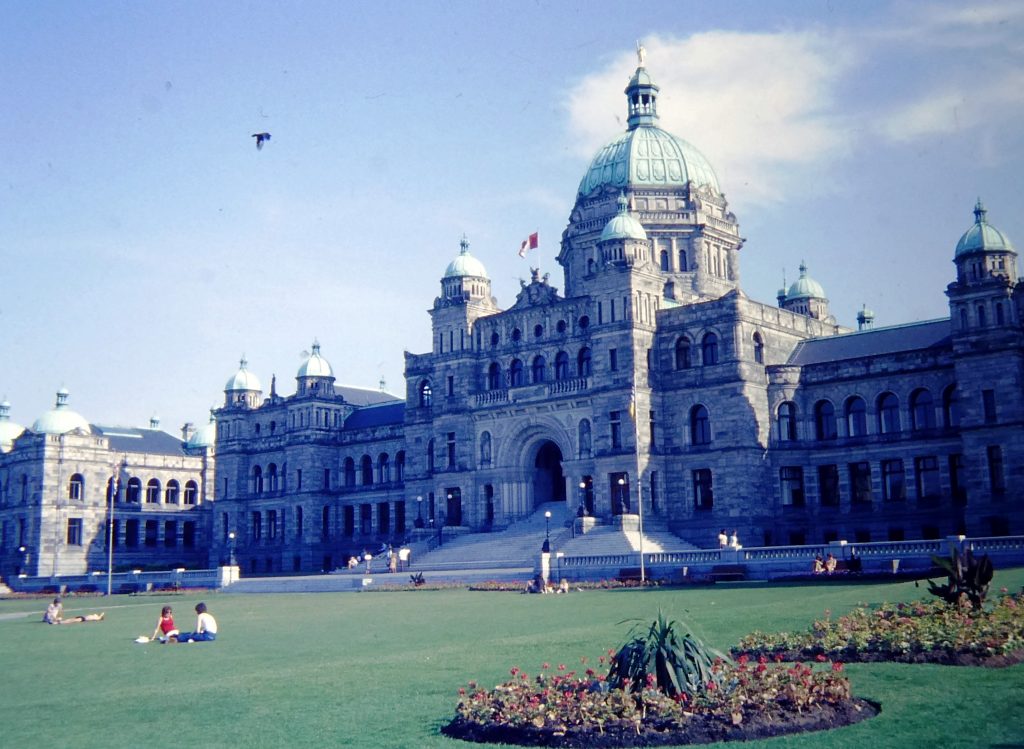 Victoria is the capital city of the Province of British Columbia, and we were anchored right by the marvellously Victorian buildings of the BC Parliament and the majestic old Empress Hotel that overlooked us. We enjoyed wandering round such places as well as the superb museums, one of which - the Maritime Museum - has Guzzwell’s tiny “Trekka” and Voss’s “Tilikum”, the schooner-rigged Indian war canoe which Voss sailed from Victoria to London via Australia around the turn of the century. We were fascinated to learn that Voss’s first stop on that voyage had been at Penrhyn Island in the Central Pacific where we had recently spent so many happy weeks, and that his main fear on approaching it had been of the natives, who were described as “man-eating savages” in his sailing directions! In the event, he was made as welcome as we were, 82 years later.
Victoria is the capital city of the Province of British Columbia, and we were anchored right by the marvellously Victorian buildings of the BC Parliament and the majestic old Empress Hotel that overlooked us. We enjoyed wandering round such places as well as the superb museums, one of which - the Maritime Museum - has Guzzwell’s tiny “Trekka” and Voss’s “Tilikum”, the schooner-rigged Indian war canoe which Voss sailed from Victoria to London via Australia around the turn of the century. We were fascinated to learn that Voss’s first stop on that voyage had been at Penrhyn Island in the Central Pacific where we had recently spent so many happy weeks, and that his main fear on approaching it had been of the natives, who were described as “man-eating savages” in his sailing directions! In the event, he was made as welcome as we were, 82 years later.
Victoria is a lovely little city, playing up its English / Scottish heritage for the tourists a bit, but in a generally inoffensive manner. To see afternoon tea being taken at the old Empress Hotel, right at the waterfront, was to take me back to the same ceremony at the Station Hotel in Edinburgh, where I used to stay with my parents what seemed like a millennium ago. The BC museum is in a new building in Victoria, and is one of the most beautifully assembled and presented collections we have seen. We visited twice. It was an excellent introduction to the history (European and pre-European) of the Pacific Northwest. And, back at anchor, we were often visited by friendly local sailors for a chat and with good advice.
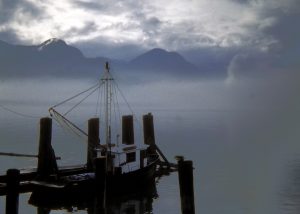 After four busy days in the harbour, the short-lived heat wave was already receding as we sailed towards our next prime target, Vancouver. In little or no wind we motored generally north through the multitude of Gulf Islands, many of them shrouded in mist. Our first stop in the islands was at Montague Harbour, near the south end of Galiano Island. This is a beautiful nearly landlocked bay which is a marine park. We picked up a marine park mooring for a very quiet night in this lovely place, with several boats around but not crowded. We had even
After four busy days in the harbour, the short-lived heat wave was already receding as we sailed towards our next prime target, Vancouver. In little or no wind we motored generally north through the multitude of Gulf Islands, many of them shrouded in mist. Our first stop in the islands was at Montague Harbour, near the south end of Galiano Island. This is a beautiful nearly landlocked bay which is a marine park. We picked up a marine park mooring for a very quiet night in this lovely place, with several boats around but not crowded. We had even 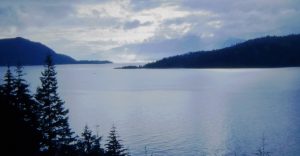 seen a bit of sun during the afternoon. The following afternoon we had a gentle sail up to Telegraph Harbour on Thetis Island, and the next day went on up to Degnen Bay, a quiet fishing harbour at the tip of Galiano. From there we motored through the narrow and sometimes turbulent Gabriola Passage, and under sail crossed the Strait of Georgia to Burrard Inlet, the gateway to Vancouver Harbour on the mainland. The weather so far had been murky and showery, and it was cool by the time we came to our berth at the Vancouver Rowing Club marina.
seen a bit of sun during the afternoon. The following afternoon we had a gentle sail up to Telegraph Harbour on Thetis Island, and the next day went on up to Degnen Bay, a quiet fishing harbour at the tip of Galiano. From there we motored through the narrow and sometimes turbulent Gabriola Passage, and under sail crossed the Strait of Georgia to Burrard Inlet, the gateway to Vancouver Harbour on the mainland. The weather so far had been murky and showery, and it was cool by the time we came to our berth at the Vancouver Rowing Club marina.
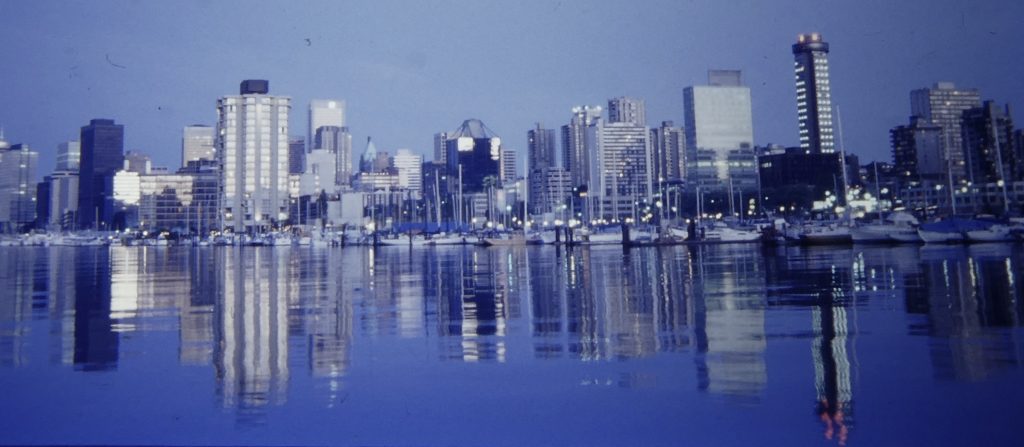 The marina lies by the city's green and pleasant Stanley Park, along with other marinas in an inlet named Coal Harbour. From our berth, once settled in, we had a staggering view across to the high buildings of downtown Vancouver and at night-time the lights of the stately city. Our berth had been arranged by our Vancouver friends Duncan and Cathy McPherson. Duncan, an orthopaedic surgeon, was at the time the President of the British Columbia Medical Association, and a few years previously had organised for me to fly to Vancouver to read a paper at the Association's annual conference and in other ways publicly explain how we in Australia had managed to implement compulsory seat-belt wearing regulations, the first in the world. The issue had become very controversial in BC. During that trip Duncan had taken me and a few friends for a weekend's sailing in local waters, and this experience had been a major factor for Norma and me in our decision to sail across the wide Pacific to the Pacific Northwest in the early stages of our voyaging.
The marina lies by the city's green and pleasant Stanley Park, along with other marinas in an inlet named Coal Harbour. From our berth, once settled in, we had a staggering view across to the high buildings of downtown Vancouver and at night-time the lights of the stately city. Our berth had been arranged by our Vancouver friends Duncan and Cathy McPherson. Duncan, an orthopaedic surgeon, was at the time the President of the British Columbia Medical Association, and a few years previously had organised for me to fly to Vancouver to read a paper at the Association's annual conference and in other ways publicly explain how we in Australia had managed to implement compulsory seat-belt wearing regulations, the first in the world. The issue had become very controversial in BC. During that trip Duncan had taken me and a few friends for a weekend's sailing in local waters, and this experience had been a major factor for Norma and me in our decision to sail across the wide Pacific to the Pacific Northwest in the early stages of our voyaging.
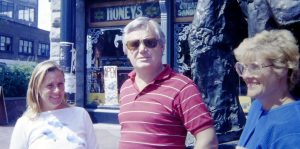
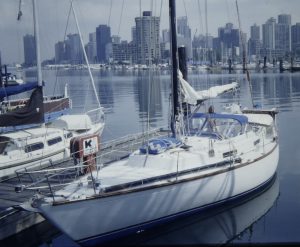 We enjoyed their hospitality and the company of several visitors to the boat over the next day or two, before catching up with Donald and Ruth Matheson, who live in West Vancouver. Don (another doctor, an ophthalmologist) and I are members of the same extended family, as Don's father was a cousin of my mother, all with Scottish roots. In beautiful weather they took us for a drive up Howe Sound, our first view of the kind of scenery we would be enjoying for the next few weeks, and we stayed the night with them - the first night in a "real" bed for nearly two years!
We enjoyed their hospitality and the company of several visitors to the boat over the next day or two, before catching up with Donald and Ruth Matheson, who live in West Vancouver. Don (another doctor, an ophthalmologist) and I are members of the same extended family, as Don's father was a cousin of my mother, all with Scottish roots. In beautiful weather they took us for a drive up Howe Sound, our first view of the kind of scenery we would be enjoying for the next few weeks, and we stayed the night with them - the first night in a "real" bed for nearly two years!
The next ten days or so were busy with socialising in peoples' homes and our boat, walking Vancouver's sights, shops and museums, and doing some local touring in a car lent us by Duncan. An especially memorable visit was to the Fort Langley National Historic Park, a splendid reconstruction of a Hudson 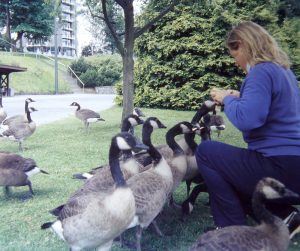 Bay trading company post. It was the site of the declaration of British Columbia as a colony in 1858. We took a few longer trips, including the Whistler ski resort and to Fraser Canyon.
Bay trading company post. It was the site of the declaration of British Columbia as a colony in 1858. We took a few longer trips, including the Whistler ski resort and to Fraser Canyon.
We also did a fair bit of work on the boat, given the luxury of a marina berth with electricity. The biggest task was to fit a much-needed kerosene cabin heater, which was to get a lot of use in the months and indeed years to come. It would have been a godsend on the passage from Hawaii!
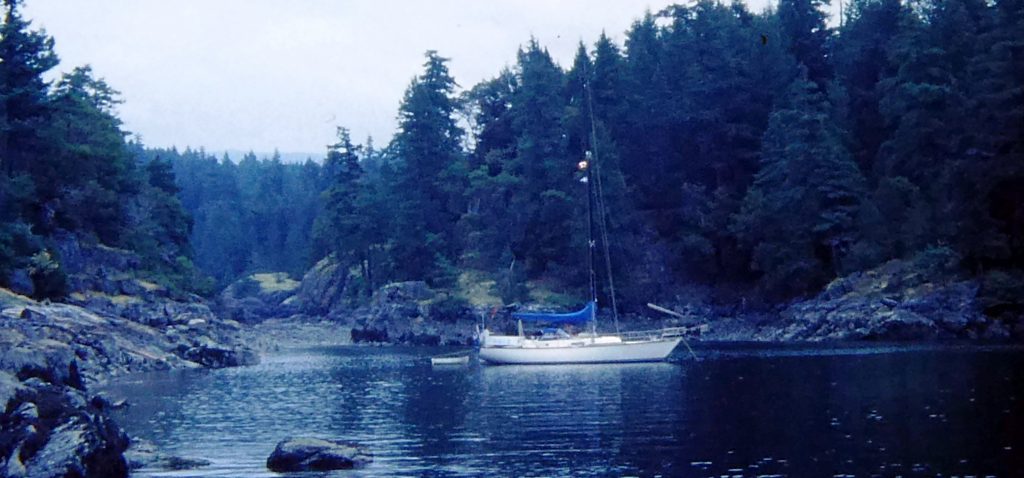
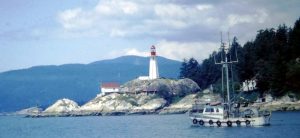 After 18 days of all this activity we said farewell to our Vancouver friends and family and finally pulled out of the marina. Our route northwards up the Strait of Georgia was to take us into some of the lovely anchorages along the mainland, on the east side of the wide waterway. Many have evocative names, such as Snug Cove, our first anchorage out of Vancouver, in the outer reaches of the expansive Howe Sound. The cove was in Bowen Island, over which we walked, picked berries, and fed the ducks and geese. It was a peaceful night before a typical day in the straits and sound: a gentle sail in the morning, then motoring in the afternoon to get to our planned anchorage in time. And so it was to Smuggler Cove in the Sechelt Peninsula, a small, beautiful and almost totally circular anchorage. We set a crab pot in the pouring rain. The next day we picked berries and Norma foraged for oyster and clams, plenty for the evening meal, and the crabs were beginning to cooperate by agreeing to be caught.
After 18 days of all this activity we said farewell to our Vancouver friends and family and finally pulled out of the marina. Our route northwards up the Strait of Georgia was to take us into some of the lovely anchorages along the mainland, on the east side of the wide waterway. Many have evocative names, such as Snug Cove, our first anchorage out of Vancouver, in the outer reaches of the expansive Howe Sound. The cove was in Bowen Island, over which we walked, picked berries, and fed the ducks and geese. It was a peaceful night before a typical day in the straits and sound: a gentle sail in the morning, then motoring in the afternoon to get to our planned anchorage in time. And so it was to Smuggler Cove in the Sechelt Peninsula, a small, beautiful and almost totally circular anchorage. We set a crab pot in the pouring rain. The next day we picked berries and Norma foraged for oyster and clams, plenty for the evening meal, and the crabs were beginning to cooperate by agreeing to be caught.
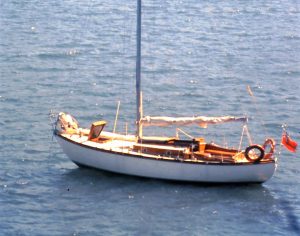 We were joined by a few other boats, and enjoyed an incredible coincidence. Our previous yacht had been a wooden 30-foot double-ended sloop, Jasnar (left) built in the late 1940s and which had sailed in two Sydney-Hobart races. We sold her while building Cera, and knew that she had then also sailed to the Pacific Northwest under new ownership, largely single-handed. Over drinks on an adjacent couple's boat, we established that the wife had crewed on Jasnar from French Polynesia to Hawaii! We expressed our hearty admiration for her guts and endurance, because Jasnar, for ocean-going, was a small and very wet boat. (She was eventually sailed back to Sydney, and our home base in Pittwater.)
We were joined by a few other boats, and enjoyed an incredible coincidence. Our previous yacht had been a wooden 30-foot double-ended sloop, Jasnar (left) built in the late 1940s and which had sailed in two Sydney-Hobart races. We sold her while building Cera, and knew that she had then also sailed to the Pacific Northwest under new ownership, largely single-handed. Over drinks on an adjacent couple's boat, we established that the wife had crewed on Jasnar from French Polynesia to Hawaii! We expressed our hearty admiration for her guts and endurance, because Jasnar, for ocean-going, was a small and very wet boat. (She was eventually sailed back to Sydney, and our home base in Pittwater.)
We then moved up a short way to Secret Cove at the invitation of Duncan in his yacht Carronade, who was up there with a racing fleet. We joined the crews for a post-race party. Then it was on up to Blind Bay, where we tucked into a little cove between Hardy Island and a little islet and Norma again collected up many delicious clams and large oysters. We were surrounded by green marine parkland, lovely to walk through, and, as everywhere round here, we could always look up to the backdrop of snow-tipped mountains.
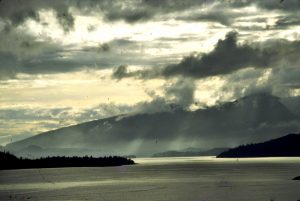
 We found the fiord-like inlets to be thick with cold, low clouds. But we were happy enough to stay quiet and explore at great leisure one of the world’s beauty spots. Cera’s motor did get a lot of use, a contrast to the windy Pacific; one would have to be supremely patient to cruise up there without one, and much of the time we did as the local sailors did and powered everywhere, sometimes with the mainsail up “for decoration”, as Norma said. Norma went into full hunter-provider mode in these waters. This part of the world is renowned for its wild berries. They grow by the million and in wide variety, and before leaving the area Norma had made 16 bottles of blackberry jam and preserved several more jars of delicious fruit, when not threatening the local seafood population. There are as many clams as you want to take, crabs walk into the pot five or six at a time, and bottom fish – particularly a local form of rock cod, which the people there rather scorn – are usually pretty easy to catch. Once we found out how, we landed a few salmon – the fish in these waters of course, and delicious (but not we thought, quite as good as the Atlantic salmon, its close relative.)
We found the fiord-like inlets to be thick with cold, low clouds. But we were happy enough to stay quiet and explore at great leisure one of the world’s beauty spots. Cera’s motor did get a lot of use, a contrast to the windy Pacific; one would have to be supremely patient to cruise up there without one, and much of the time we did as the local sailors did and powered everywhere, sometimes with the mainsail up “for decoration”, as Norma said. Norma went into full hunter-provider mode in these waters. This part of the world is renowned for its wild berries. They grow by the million and in wide variety, and before leaving the area Norma had made 16 bottles of blackberry jam and preserved several more jars of delicious fruit, when not threatening the local seafood population. There are as many clams as you want to take, crabs walk into the pot five or six at a time, and bottom fish – particularly a local form of rock cod, which the people there rather scorn – are usually pretty easy to catch. Once we found out how, we landed a few salmon – the fish in these waters of course, and delicious (but not we thought, quite as good as the Atlantic salmon, its close relative.)
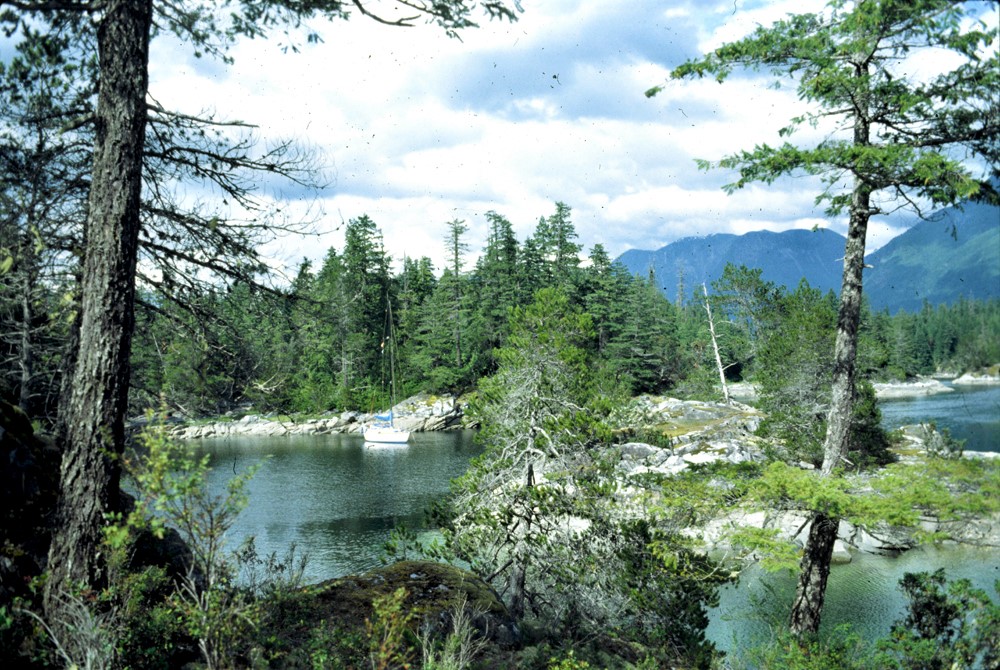
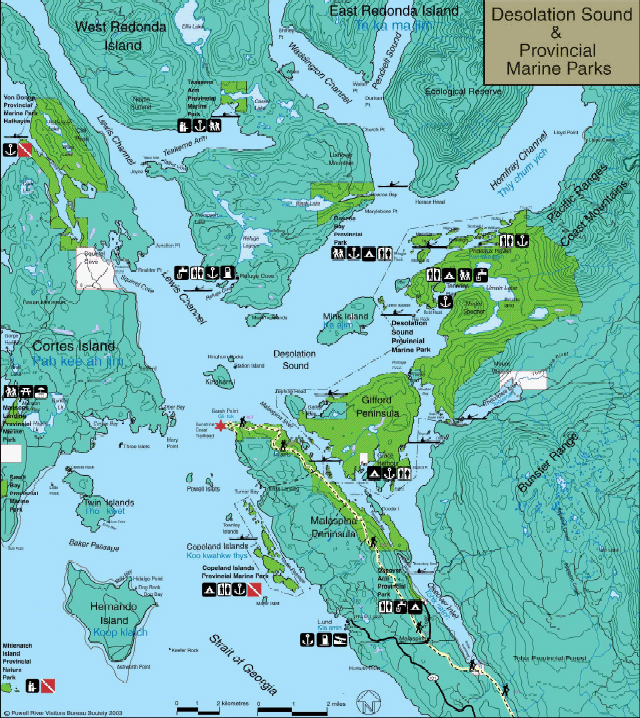 It remained rather drizzly as we motored on up Malaspina Strait, past dozens of little islands and round Sarah Point into the Desolation Sound marine park, a major destination for our explorations. Desolation Sound is an area named by Captain George Vancouver (on what was obviously a bad day) during his exploration of the area in 1792. He wrote: "there was not a single prospect that was pleasing to the eye". He had much the same conditions as us – constant overcast, much drizzle, often poor visibility, and mosquitoes. But it is a region of outstanding beauty, and one of the world's greatest cruising destinations. For years we had dreamed of making it here in a yacht, and this we had achieved at last.
It remained rather drizzly as we motored on up Malaspina Strait, past dozens of little islands and round Sarah Point into the Desolation Sound marine park, a major destination for our explorations. Desolation Sound is an area named by Captain George Vancouver (on what was obviously a bad day) during his exploration of the area in 1792. He wrote: "there was not a single prospect that was pleasing to the eye". He had much the same conditions as us – constant overcast, much drizzle, often poor visibility, and mosquitoes. But it is a region of outstanding beauty, and one of the world's greatest cruising destinations. For years we had dreamed of making it here in a yacht, and this we had achieved at last.
We settled into an inner bay in Grace Harbour, almost completely landlocked and surrounded by forest. Once again we were by ourselves, and were visited by an incredible variety of wild life. This was a particularly satisfying aspect of our time in Canada, to see so many different animals and birds. Deer 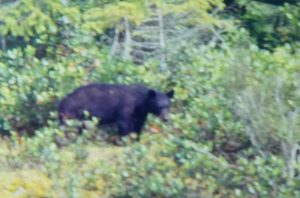 in the mossy woods were commonplace. In the wild we saw a black bear berry-picking on a mossy knoll by the shore, and I managed to get a telephoto shot of him from the dinghy before he lolloped off into the trees. Around the boat at anchorage it was commonplace to see seals and, delightful in their play, otters in small, shy groups. Scores of magnificent bald eagles soared overhead. The “bald” (actually, a white-headed ) sea eagle is common here, in contrast to the United States, where it is their national emblem.
in the mossy woods were commonplace. In the wild we saw a black bear berry-picking on a mossy knoll by the shore, and I managed to get a telephoto shot of him from the dinghy before he lolloped off into the trees. Around the boat at anchorage it was commonplace to see seals and, delightful in their play, otters in small, shy groups. Scores of magnificent bald eagles soared overhead. The “bald” (actually, a white-headed ) sea eagle is common here, in contrast to the United States, where it is their national emblem.
We went a little way up Homfray Channel and into Prideaux Haven, also in the Desolation Sound marine park, and crept in through a narrow channel between 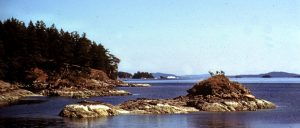 the scores of islets. We tied stern-to to Copplestone Island, in a tiny cove all to ourselves again. We dinghied round to the larger Melanie Cove, past a stoic little deer chewing the cud and walked up through enchanting rain forest, moss-draped trees, at the head of the cove.
the scores of islets. We tied stern-to to Copplestone Island, in a tiny cove all to ourselves again. We dinghied round to the larger Melanie Cove, past a stoic little deer chewing the cud and walked up through enchanting rain forest, moss-draped trees, at the head of the cove.
The weather prevented us going further north, as we might have liked, because the fiords become steeper and snowier further up. Still, the inlets we did see were sufficiently fiord-like to be satisfying, and the snow-capped mountains emerged as a backdrop at intervals. It was the “micro-scenery” which was, rather surprisingly, so gorgeous – an amazing array of greenery, millions of rocky promontories and islets, wild flowers and wild life.
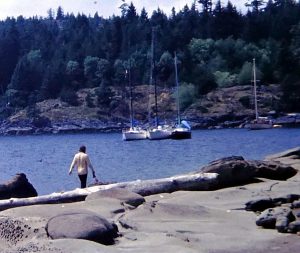 The seafood was so abundant that once again we became almost self-sufficient. The fishing required some work, especially if the aim was salmon, but we nearly always caught enough for us. Red rock crab were so numerous that we generally had to shake some off the outside of the pot before selecting only the biggest to keep, and there were thousands of clams and oysters for the taking within yards of most of the anchorages. “Red tide”, or paralytic shellfish poisoning, is a problem in the summer, but we followed local advice and custom rather than the very pessimistic warnings put out by the authorities, and had no problems.
The seafood was so abundant that once again we became almost self-sufficient. The fishing required some work, especially if the aim was salmon, but we nearly always caught enough for us. Red rock crab were so numerous that we generally had to shake some off the outside of the pot before selecting only the biggest to keep, and there were thousands of clams and oysters for the taking within yards of most of the anchorages. “Red tide”, or paralytic shellfish poisoning, is a problem in the summer, but we followed local advice and custom rather than the very pessimistic warnings put out by the authorities, and had no problems.
The other side of the Homfray Channel lies the small settlement of Refuge Cove, on Redonda Island. It's the only place to buy provisions in Desolation Sound, and we made use of the Refuge Cove General Store, with its own wharf, to do so. We thought it was expensive, but these remote little stores inevitably are, anywhere in the world. From there we actually sailed in the sun across the Lewis Channel to Squirrel Cove on Cortes Island, but the weather soon reverted to rain. It dried up overnight, and we motored up to the northern-most point of our cruise in Canada, as we rounded the tip of Cortes. At this point were were at latitude 50.2 degrees north, and we vowed that this was as far north as we would ever want to be again, during our voyaging years. However, we were to break this agreement several times in coming years.
 After turning south we spent a couple of nights in a pleasant anchorage at the end of the deep inlet of Von Donop, and caught up with some boat maintenance. We walked a logging trail through the forest and braved the obvious presence of several snakes: some brown with black spots, and others green with long black stripes. Seals swam around the boat. Logging is a very big industry in these parts. Log rafts are constructed along the waterfronts and floated to timber yards. Many logs go astray, and floating timber presents a hazard that requires a careful lookout. Particularly dangerous are those that float vertically, hard to see, called "deadheads".
After turning south we spent a couple of nights in a pleasant anchorage at the end of the deep inlet of Von Donop, and caught up with some boat maintenance. We walked a logging trail through the forest and braved the obvious presence of several snakes: some brown with black spots, and others green with long black stripes. Seals swam around the boat. Logging is a very big industry in these parts. Log rafts are constructed along the waterfronts and floated to timber yards. Many logs go astray, and floating timber presents a hazard that requires a careful lookout. Particularly dangerous are those that float vertically, hard to see, called "deadheads".
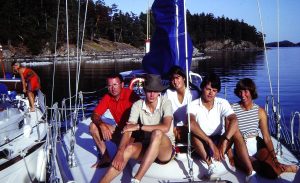 We were joined by Duncan and Cathy McPherson and their family in Carronade, and welcomed Duncan's help in improving our fishing skills. Together we sailed down along Georgia Strait and past Texada Island to Scottie Bay on Lasqueti Island, where we rafted up with them for the night. The next afternoon we both moved round Lasqueti and into False Bay. This was a spacious and splendid anchorage, especially in the calm and pleasant weather conditions that had now settled in, and we were to spend just over a week there. Duncan was very busy with medico-political matters, and during this time I flew out of the bay with him on a float plane for a couple of days in Vancouver. Norma and Cathy went berrying and clamming, living off the land. It did appear that summer was trying to arrive at last, but it was nice for only a couple of days.
We were joined by Duncan and Cathy McPherson and their family in Carronade, and welcomed Duncan's help in improving our fishing skills. Together we sailed down along Georgia Strait and past Texada Island to Scottie Bay on Lasqueti Island, where we rafted up with them for the night. The next afternoon we both moved round Lasqueti and into False Bay. This was a spacious and splendid anchorage, especially in the calm and pleasant weather conditions that had now settled in, and we were to spend just over a week there. Duncan was very busy with medico-political matters, and during this time I flew out of the bay with him on a float plane for a couple of days in Vancouver. Norma and Cathy went berrying and clamming, living off the land. It did appear that summer was trying to arrive at last, but it was nice for only a couple of days.
 We had a pleasant sail together down back to the northern Gulf Islands, busily dealing with shifting winds. We came to anchor off a Royal Vancouver Yacht Club wharf in Silva Bay, on Gabriola Island, protected all around by a collection of the small "Flat Top" islets. The anchorage is very popular, being not far from Vancouver, and there are facilities for stores that, again, were expensive. But a salmon was brought to us by a friendly yachtie, another was caught while we were out fishing with Duncan, and Norma picked enough blackberries to fill several bottles. We continued to meander along through more lttle islands and anchorages, including Pirates Cove, Ladysmith Harbour, Maple Bay and Long Harbour. In the Gulf Islands the sun shone during what turned out to be the best two weeks’ weather of the summer. We found the long evenings to be the loveliest time of the day, as the slow-setting sun cast long shadows from the pines and lit the glassy waters of the coves with soft pastel blues and pinks. But finally, as July came to and end, we shared an end-of-cruise dinner with Duncan and Cathy before splitting up the next day, sailing out through Active Pass and back over to Vancouver.
We had a pleasant sail together down back to the northern Gulf Islands, busily dealing with shifting winds. We came to anchor off a Royal Vancouver Yacht Club wharf in Silva Bay, on Gabriola Island, protected all around by a collection of the small "Flat Top" islets. The anchorage is very popular, being not far from Vancouver, and there are facilities for stores that, again, were expensive. But a salmon was brought to us by a friendly yachtie, another was caught while we were out fishing with Duncan, and Norma picked enough blackberries to fill several bottles. We continued to meander along through more lttle islands and anchorages, including Pirates Cove, Ladysmith Harbour, Maple Bay and Long Harbour. In the Gulf Islands the sun shone during what turned out to be the best two weeks’ weather of the summer. We found the long evenings to be the loveliest time of the day, as the slow-setting sun cast long shadows from the pines and lit the glassy waters of the coves with soft pastel blues and pinks. But finally, as July came to and end, we shared an end-of-cruise dinner with Duncan and Cathy before splitting up the next day, sailing out through Active Pass and back over to Vancouver.
Our berth there this time was Duncan's slip, in the RVYC marina in the suburb of Jericho, near the University of BC. The evening we arrived we joined up again with Don and Ruth Matheson, for dinner and a couple of nights catching up and some local exploring.
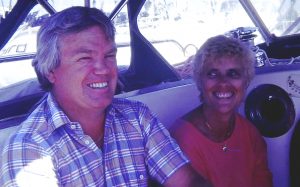
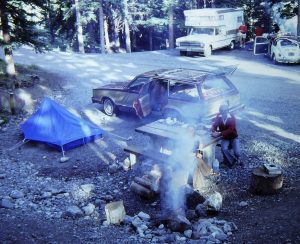 Off the yacht, then, and for a while a complete change in our mode of travel. Don had most kindly lent us his large, comfortable and quiet Pontiac wagon. We loaded it up with the camping gear we had been carrying in Cera for just such an eventuality, and went off for a ten-day camping tour of the Rockies and the nearer parts of Alberta. This was a hugely enjoyable change from life on the ocean wave. The Rockies were breathtaking, and we drove the most scenic route, the Icefields Parkway, in both directions. There was little snow except on the highest peaks, but we commonly camped within sight of the snow line at one of the marvellous camp sites of the Canadian National Park system, where piles of wood are provided for the essential camp fire and where stern warnings are given about leaving out
Off the yacht, then, and for a while a complete change in our mode of travel. Don had most kindly lent us his large, comfortable and quiet Pontiac wagon. We loaded it up with the camping gear we had been carrying in Cera for just such an eventuality, and went off for a ten-day camping tour of the Rockies and the nearer parts of Alberta. This was a hugely enjoyable change from life on the ocean wave. The Rockies were breathtaking, and we drove the most scenic route, the Icefields Parkway, in both directions. There was little snow except on the highest peaks, but we commonly camped within sight of the snow line at one of the marvellous camp sites of the Canadian National Park system, where piles of wood are provided for the essential camp fire and where stern warnings are given about leaving out 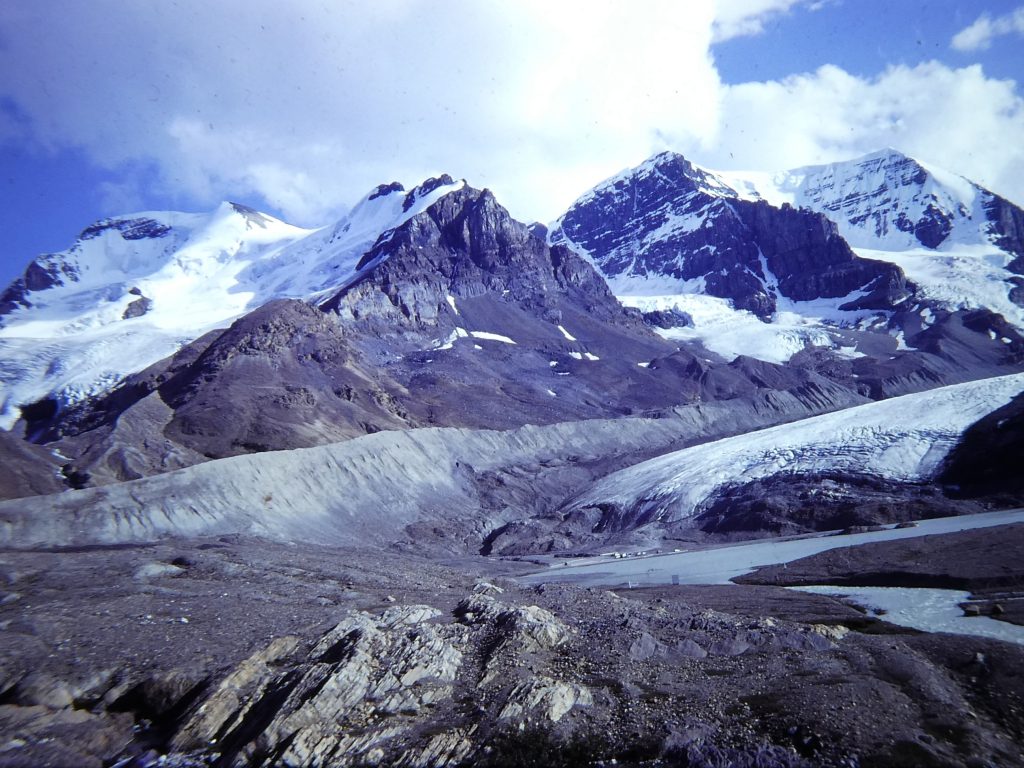 food which might attract bears. We hiked on the Athabasca Glacier, approached within feet of an enormous elk, and took innumerable photos of craggy mountains reflected in glassy, glacial lakes.
food which might attract bears. We hiked on the Athabasca Glacier, approached within feet of an enormous elk, and took innumerable photos of craggy mountains reflected in glassy, glacial lakes.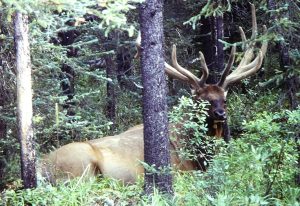
The camp sites in the National and State Parks are the best we had ever been to – plenty of space, each site with a picnic table and fireplace, plenty of firewood (which is certainly needed; one night we camped at the level of the bottom of a glacier). The prairie country was looking very good, with hay being made and much of the wheat about ready to harvest – the countryside between Calgary and Edmonton, in Alberta, we found to be strongly reminiscent of that around Orange, NSW.
As expected, we got on famously with the Canadian people. They are firmly nationalistic, close to paranoid about Big Brother USA, much 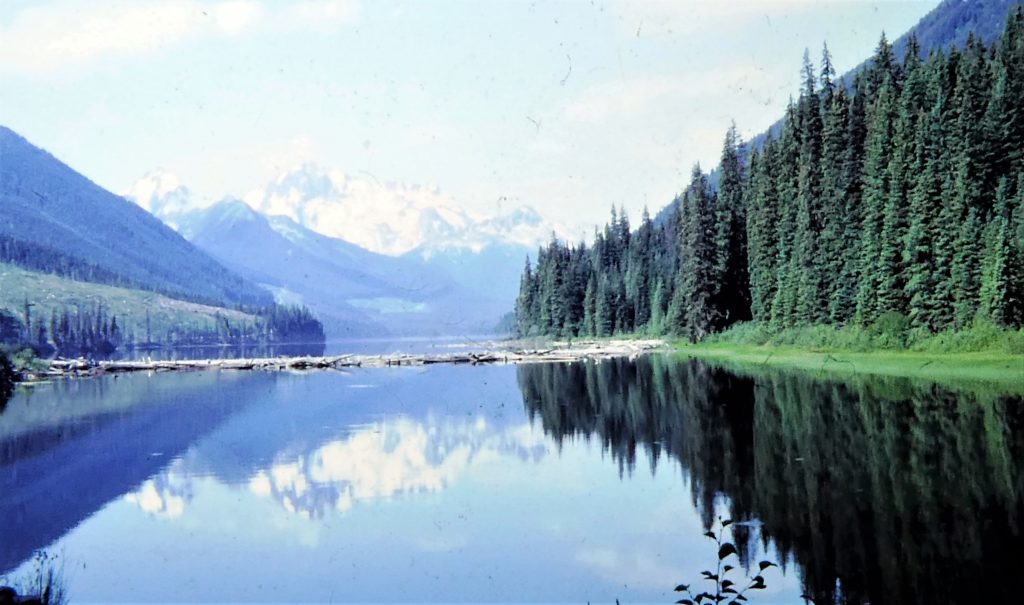 more akin to the Australasians and British than the Americans (of whom they casually speak in highly disparaging terms!). In general attitude they are closely related to the Kiwis, we thought, even to the extent that their view of the USA is much the same as the New Zealanders’ view of Australia! In summary, we found it to be a cardinal sin to confuse a Canadian with an American, and we had to be very careful because they can’t understand why we can’t tell the difference from the accent!
more akin to the Australasians and British than the Americans (of whom they casually speak in highly disparaging terms!). In general attitude they are closely related to the Kiwis, we thought, even to the extent that their view of the USA is much the same as the New Zealanders’ view of Australia! In summary, we found it to be a cardinal sin to confuse a Canadian with an American, and we had to be very careful because they can’t understand why we can’t tell the difference from the accent!
In Edmonton we caught up with old friends from RAF days, David and Pat Amies, whom we saw many times again during the yeas that David came to work in Australia. We visited Jasper, staying at a lovely camp site by the Snaring River and enjoying a chicken barbequed on the camp fire. There was another particularly lovely site by a lakeside at Marble Canyon, near Lillooet.
We had enjoyed lovely weather (fortunately, given the basic nature of our camping gear), and this continued when we returned to Vancouver and the boat at the RVYC.
By now it was the middle of August, and it was time to be getting to sea again. The plan was to get south to northern California in time to avoid the autumn storms that are notorious along the Pacific coast of Oregon.
Our first step south was to cross the Strait of Georgia yet again, return to the Gulf Islands through Active Pass and come to anchor in warm sun at Prevost Island, still in Canadian waters. From there, we sailed to the United States of America, namely San Juan Island in the State of Washington, at the mouth of Puget Sound.
The American San Juan Islands are geographically similar to the Canadian Gulf Islands, but quite different to visit – much more developed, with marinas rather than peaceful little coves. They served to ease us into the American way of life which we were about to experience and share during the coming months.
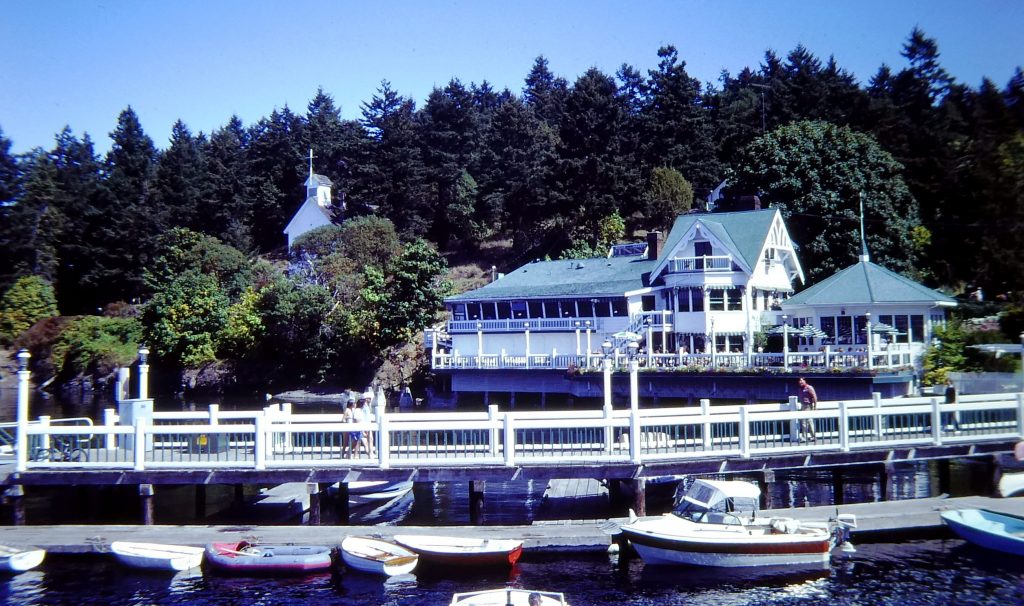 Roche Harbour, at the north end of San Juan Island, is a Customs port where friendly officials formally “entered” us into the United States. The well-protected harbour is part of a fascinating resort based on an old limestone mining operation, where we anchored just off the attractive resort settlement, an old pub and buildings. The marina was packed with huge American motor vessels, one carrying a helicopter, very rare those days. Boats from our part of the world were practically unknown in these waters, and we suffered the embarrassment of having “Waltzing Matilda” played for us at one restaurant, while west coast sailors told us how much they hoped “Australia II” would take the upcoming America’s Cup away from the New York Yacht Club.
Roche Harbour, at the north end of San Juan Island, is a Customs port where friendly officials formally “entered” us into the United States. The well-protected harbour is part of a fascinating resort based on an old limestone mining operation, where we anchored just off the attractive resort settlement, an old pub and buildings. The marina was packed with huge American motor vessels, one carrying a helicopter, very rare those days. Boats from our part of the world were practically unknown in these waters, and we suffered the embarrassment of having “Waltzing Matilda” played for us at one restaurant, while west coast sailors told us how much they hoped “Australia II” would take the upcoming America’s Cup away from the New York Yacht Club.
It was all very busy, though, and we sailed across to Orcas Island and Deer Harbour for a more peaceful anchorage, calm at night but not otherwise a particularly good one, wide open to the south. From there we motored round to West Sound, where we tied up to a jetty at the home of a Canadian couple who, way back in Grace Harbour, had offered us its use during our visit to the San Juans. They were splendid company, George and Meg Hellyer, a British-born US citizens who had led an active and interesting life, our kind of people. Finally, after this quick tour of the San Juans, we returned to Orcas Island and anchored in deep water in Friday Harbour, a major centre, to get ready for our departure and another Pacific passage.
West Coast USA
We timed our departure from Friday Harbour in the San Juans to transit the Strait of Juan de Fuca during the night, when the prevailing strong-to-gale force westerlies which howl down it usually moderated. Wrong! First, as the sun set in our eyes, we had a nightmare time wending our way through a spider’s web of fishing nets, set in their hundreds (we found out later) during the few days of the year when gill-netting is permitted in the area. Then, the wind did not drop as expected and we had a rotten slog out against the steep seas of this turbulent waterway, finally rounding Cape Flattery with a sigh of relief the next morning.
It was light winds for a while, and while we were sailing peacefully south down the Washington coast, we came across some sort of craft we couldn't identify that was meandering across our path. We didn't know what it was doing, but finally recognised it was a submarine, just awash. We called it to request advice on its intentions, which after a couple of calls it acknowledged and pulled away - as did several trawlers a mile or two away, bristling with antennas, which rapidly headed for the horizon. Understanding all by then, we realised that the US Navy cannot have been too pleased with our identifying the sub for the surveillance fleet that was shadowing them!
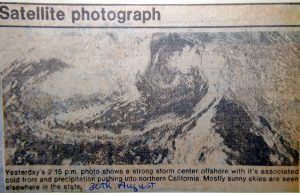 In this initially pleasant weather we confidently predicted a sleigh ride down the coast to San Francisco, our first passage with the "normal" prevailing winds since leaving Fiji. Wrong again! First, the wind died altogether. Reluctant to burn much fuel at the beginning of a passage, we slopped around for the daylight hours and motored for a part of each night to get a few miles under our keel.
In this initially pleasant weather we confidently predicted a sleigh ride down the coast to San Francisco, our first passage with the "normal" prevailing winds since leaving Fiji. Wrong again! First, the wind died altogether. Reluctant to burn much fuel at the beginning of a passage, we slopped around for the daylight hours and motored for a part of each night to get a few miles under our keel.
When the wind did come in, about a third of the way down, it did so as a result of a strong storm centre off the Oregon coast, with an associated cold front pushing into northern California. This combination brought stiff winds from the south! So, we started a process of tacking 50 miles out to sea then 50 miles in down the coast, battling steep and irregular seas. The gloomy weather men on the radio were muttering about gales and strong wind warnings as we persevered with this frustrating passage. Not that we had much choice – by the time we seriously considered putting in to one of the sand-barred river harbours of the Oregon/northern California coast, the passes were all shut by the weather and not accessible. This was exactly the kind of autumn storm we had left the Pacific NW before the end of August to avoid!
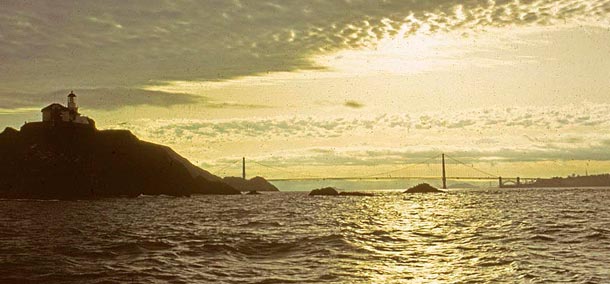 After a mostly dreadful 10-day passage down this notorious coast, we finally came to towards harbour at San Francisco in most beautiful conditions, with the sun rising in unusually clear skies behind the gigantic but wispy-looking Golden Gate Bridge, a lovely introduction to this lovely city. To sail through the Golden Gate must be one of the world’s most spectacular harbour entrances. The passage we had just endured retreated to the memory bank.
After a mostly dreadful 10-day passage down this notorious coast, we finally came to towards harbour at San Francisco in most beautiful conditions, with the sun rising in unusually clear skies behind the gigantic but wispy-looking Golden Gate Bridge, a lovely introduction to this lovely city. To sail through the Golden Gate must be one of the world’s most spectacular harbour entrances. The passage we had just endured retreated to the memory bank.
On entering San Francisco bay we first made for the St Francis Yacht Club, but there was no room there or at the nearby municipal marina. We were running out of options by this time. However, in choppy water typical of the Bay, we made our way further east down the harbour and just past Fishermans Wharf. We came then to Pier 39, where we knew from the guidebooks there was a marina that might be able to take us.
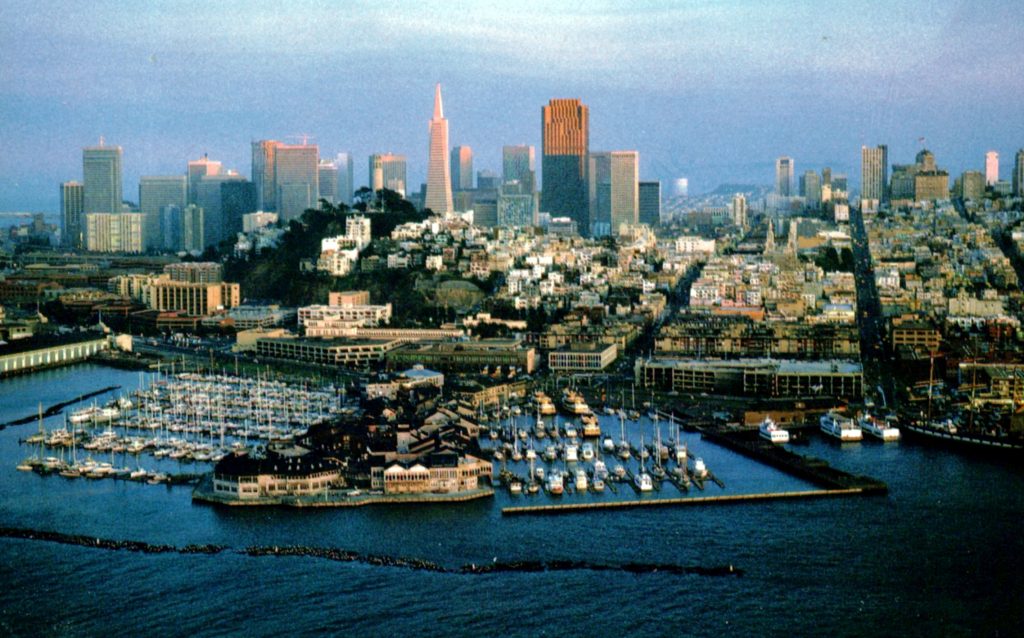 Pier 39 is an attractive reconstruction of one of the old city wharves, complete with shops, restaurants and a superb resident traditional jazz band. Less attractive was the marina itself, which had been badly knocked about by the storms of the previous winter. The breakwater had been destroyed, and had been replaced by a totally inadequate system of floating tyres roped together. This did very little to abate the rolling wakes of passing ships, ferries and cruise boats. Further, we were faced by intimidating signs saying "No Trespassing" and "NO guest berths". However, there were several boats there, and many looked liked cruising visitors. "Let's just go in and see", said Norma. So we did, and friendly girl in the marina office explained that the marina was not officially in service, awaiting a rebuild, but we could stay as long as we wanted at a very low cost!
Pier 39 is an attractive reconstruction of one of the old city wharves, complete with shops, restaurants and a superb resident traditional jazz band. Less attractive was the marina itself, which had been badly knocked about by the storms of the previous winter. The breakwater had been destroyed, and had been replaced by a totally inadequate system of floating tyres roped together. This did very little to abate the rolling wakes of passing ships, ferries and cruise boats. Further, we were faced by intimidating signs saying "No Trespassing" and "NO guest berths". However, there were several boats there, and many looked liked cruising visitors. "Let's just go in and see", said Norma. So we did, and friendly girl in the marina office explained that the marina was not officially in service, awaiting a rebuild, but we could stay as long as we wanted at a very low cost!
 While not being the most comfortable berth, it was very convenient for the tourist attractions which abound on the city's waterfront. After a sleep we wandered around Fishermans Wharf, touristy but fun, had lunch there, and in the late afternoon went to "Earthquake McGoon's" for excellent jazz by Turk Murphy and his resident band. He was famous in these parts, very much in the mould of the Lyttletons and Barbers with whom we grew up, as well as some of the better Oz trad bands. Who would not enjoy the street musicians, the jugglers, the vibrant enthusiasm of Americans – young and old – at tourist play, even if the precinct is a bit kitsch.
While not being the most comfortable berth, it was very convenient for the tourist attractions which abound on the city's waterfront. After a sleep we wandered around Fishermans Wharf, touristy but fun, had lunch there, and in the late afternoon went to "Earthquake McGoon's" for excellent jazz by Turk Murphy and his resident band. He was famous in these parts, very much in the mould of the Lyttletons and Barbers with whom we grew up, as well as some of the better Oz trad bands. Who would not enjoy the street musicians, the jugglers, the vibrant enthusiasm of Americans – young and old – at tourist play, even if the precinct is a bit kitsch.
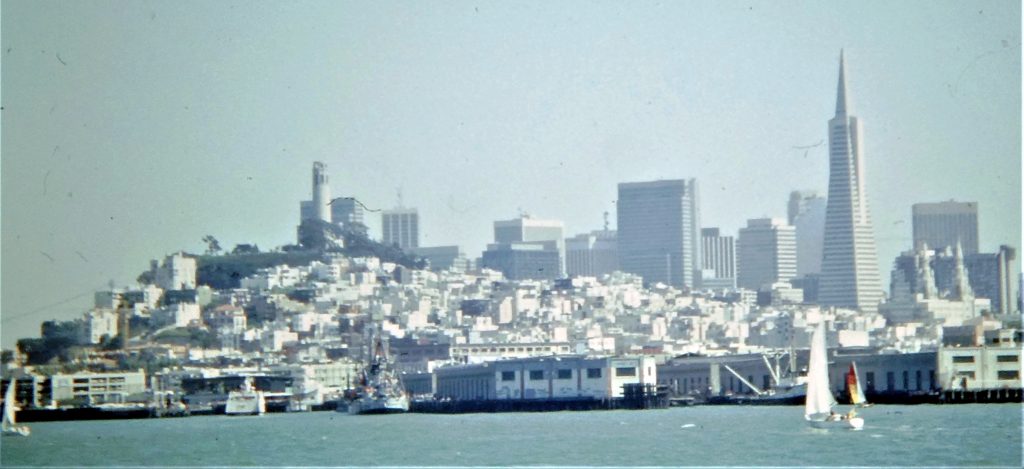 Fascinating downtown San Francisco was an easy bus ride or a reasonable walk away. We were in for a busy and expensive time in the city, where we went through an energetic phase of exploration, maintenance, re-equipping and restocking. After seven years of sailing, including two years’ full-time voyaging, our yacht needed some refurbishing and new equipment, including new upholstery for the saloon. We also needed to buy a stack of charts and restock the boat with basic supplies in case of shortages in Central America. Attractive stores of every conceivable kind tempted us with the world’s biggest choice of consumer goods, of a nautical nature and otherwise, and the generosity of friends who were willing to lend us their cars meant that much of the time we were live-aboard tourists rather than cruising sailors. However, at the end of all this the boat was back to pristine condition and weighed down by basic provisions which, rightly or wrongly, we thought might be hard to obtain in Central America.
Fascinating downtown San Francisco was an easy bus ride or a reasonable walk away. We were in for a busy and expensive time in the city, where we went through an energetic phase of exploration, maintenance, re-equipping and restocking. After seven years of sailing, including two years’ full-time voyaging, our yacht needed some refurbishing and new equipment, including new upholstery for the saloon. We also needed to buy a stack of charts and restock the boat with basic supplies in case of shortages in Central America. Attractive stores of every conceivable kind tempted us with the world’s biggest choice of consumer goods, of a nautical nature and otherwise, and the generosity of friends who were willing to lend us their cars meant that much of the time we were live-aboard tourists rather than cruising sailors. However, at the end of all this the boat was back to pristine condition and weighed down by basic provisions which, rightly or wrongly, we thought might be hard to obtain in Central America.
After a week at Pier 39 we crossed San Francisco Bay to Sausalito. We were having a few engine problems so, pending a (successful) fix at Sausalito, we sailed all the way. In the shifty winds of that morning and the swift tidal streams for which the bay is notorious this took a while and a fair bit of caution. We were granted a marina berth for the weekend to fix the engine, then went out to anchor in the channel off the town. 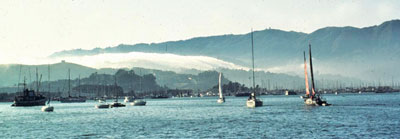 We then spent most of the rest of our time in the Bay at anchor in Richardson Bay off Sausalito, the only practical place in the Bay area for long-term anchorage.
We then spent most of the rest of our time in the Bay at anchor in Richardson Bay off Sausalito, the only practical place in the Bay area for long-term anchorage.
We enjoyed a very hot spell for a while but to the relief of the local citizens what they call their “natural air conditioning” soon rolled in : the famous fog. Foghorns droned through the night, and one side of the Bay became invisible from the other as a solid white tongue of sea-level cloud pierced the Golden Gate, from the sea to the city. The ever-present wind does not blow the fog away but swirls it like a fluid mass, and washes it over the hills behind Sausalito so that its muggy, cool tendrils moistened us where we lay. The mid-morning sun usually burnt off the fog, as the afternoon sea breeze gained strength; weekend days were just like Sydney, the Bay a solid block of sails, with boats being driven with huge exuberance amid a mass of spray.
Norma got friendly with a local sailmaker and got lots of stuff to fix up the cockpit dodger and sails, and he was one of many to toss us the keys for his car.
We spent some time with friends met sailing in the Pacific, and particularly with a couple of European origin (Hans and Kari Mueller) whom we had met in Tonga. They had built (with their own hands) a beautiful house in a very salubrious area north of San Francisco city, reminiscent of a rather hillier Dural; with them, and with an anaesthetist and his wife, we got a taste of the highly acceptable lifestyle of the moderately-prosperous Californian. Actually it’s very like Sydney – blink in a shopping centre, or drive down a suburban street, and you could be instantly transported right across the Pacific.
In a borrowed car we toured the wine country briefly, including lunch with Bob and Nathalie Carnachan, relations of a sailor whom we met in Honolulu, a lovely couple with a profound knowledge of Californian wine. To add to this affinity, he was also a car buff and owned a superb Jaguar XK150, very reminiscent of the XK140 we owned many moons ago in London. We enjoyed Californian wines, which are really very like Australian wines – not surprising considering the similarity of growing conditions and the use of generally identical grapes. The winery “tasting houses” are the dolled-up bottle shops which front most Australian wineries these days, but they did offer the chance to taste some average wines pushed with the usual enthusiasm of their young growers.
In this part of the wine country – the Napa and Sonoma valleys – we were able to buy some of their justifiably famous cheese. Most American cheese, even the genuine dairy product as opposed to the plastic muck, we find to be soft and insipid, but the Sonoma cheese was a delicious exception.
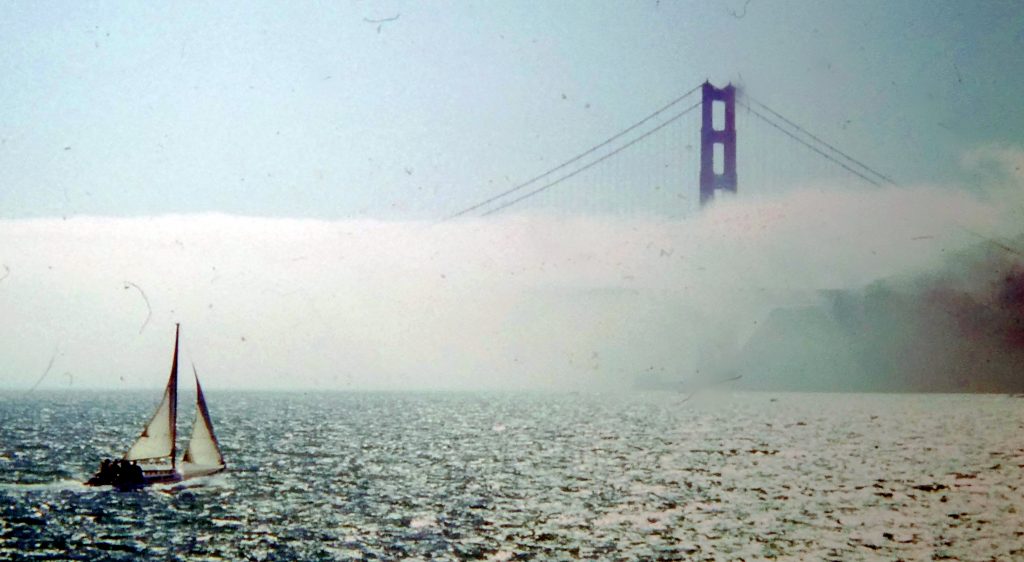 After more than three weeks we were getting ready to go when, for the first time, we had something stolen. We had been at a bar with several sailing friends talking about the very soon to come final race of the America's Cup. The Australian boat under John Bertrand and designed by Ben Lexcen (Bob Miller, for whom Norma had been working) stood a chance of taking the cup from the New York Yacht Club - an outcome which would be much welcomed by the west coast sailors we were with! Late back to the boat we left the outboard motor on the dinghy, which we normally never did - and sure enough, when we got up the next morning the motor was gone. I was in the process of complaining and wondering what we would get to replace it when Norma, more practically, was out on deck with binoculars. She saw what look like our motor on a dinghy by a big schooner across Richardson Bay, off Belvedere Island. Two kids were trying to start it, a problem we were having ourselves! We rowed across, no-one appeared, and with some alarm lest someone would appear with a gun, shouted that we were repossessing our motor and rowed rapidly back to Cera. An attempt had been made to disguise the motor by roughly painting its cover, but it ran OK. Later that day we were approached by the skipper of the schooner who, full of abject apologies, told us that the motor had been nicked by his son and a friend. He offered their services for the worst tasks we could think of to have them do, but we were relieved enough at the outcome and laughed the affair off.
After more than three weeks we were getting ready to go when, for the first time, we had something stolen. We had been at a bar with several sailing friends talking about the very soon to come final race of the America's Cup. The Australian boat under John Bertrand and designed by Ben Lexcen (Bob Miller, for whom Norma had been working) stood a chance of taking the cup from the New York Yacht Club - an outcome which would be much welcomed by the west coast sailors we were with! Late back to the boat we left the outboard motor on the dinghy, which we normally never did - and sure enough, when we got up the next morning the motor was gone. I was in the process of complaining and wondering what we would get to replace it when Norma, more practically, was out on deck with binoculars. She saw what look like our motor on a dinghy by a big schooner across Richardson Bay, off Belvedere Island. Two kids were trying to start it, a problem we were having ourselves! We rowed across, no-one appeared, and with some alarm lest someone would appear with a gun, shouted that we were repossessing our motor and rowed rapidly back to Cera. An attempt had been made to disguise the motor by roughly painting its cover, but it ran OK. Later that day we were approached by the skipper of the schooner who, full of abject apologies, told us that the motor had been nicked by his son and a friend. He offered their services for the worst tasks we could think of to have them do, but we were relieved enough at the outcome and laughed the affair off.
We left San Francisco on a Sunday afternoon in late September in a building wind and carrying more sail than we would normally do because we correctly guessed that the wind would drop that night. We soon caught a nice bonito, inevitably just in the middle of dinner. Listening to the radio at 7:15 pm we were thrilled to hear that, yes, Australia II had won the 1983 America's Cup in a thrilling finish.
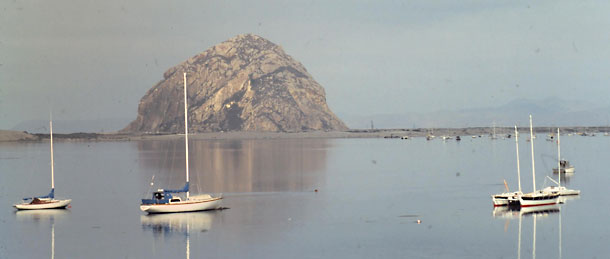 After a couple of nights sailing down the Carmel coast we reached the fishing village of Morro Bay, an enchanting place, one of the few protected no-strings anchorages on the coast of California. The most prominent feature, the volcanic plug called Morro Rock, lies right by the narrow entrance channel. The bay is a wild life refuge, with lots of pelicans and some 250 other species of birds to be seen, and is one of the only haunts outside Alaska of the rare and utterly enchanting sea otter. This beautiful creature lives entirely in the water, unjustifiably unafraid of human presence, and watches the passing parade with appealing gravity, lying on its back while floating in the water. It is one of the animal kingdom’s few tool users; it lives on oysters and abalone, the shells of which it breaks open by whacking them on a flat stone which it places on its stomach, still floating the while on its back. This is a performance that can bring tears of joy to the eyes! The sea otter is an endangered species (decimated by fur hunters) which is now groping itself back into viability.
After a couple of nights sailing down the Carmel coast we reached the fishing village of Morro Bay, an enchanting place, one of the few protected no-strings anchorages on the coast of California. The most prominent feature, the volcanic plug called Morro Rock, lies right by the narrow entrance channel. The bay is a wild life refuge, with lots of pelicans and some 250 other species of birds to be seen, and is one of the only haunts outside Alaska of the rare and utterly enchanting sea otter. This beautiful creature lives entirely in the water, unjustifiably unafraid of human presence, and watches the passing parade with appealing gravity, lying on its back while floating in the water. It is one of the animal kingdom’s few tool users; it lives on oysters and abalone, the shells of which it breaks open by whacking them on a flat stone which it places on its stomach, still floating the while on its back. This is a performance that can bring tears of joy to the eyes! The sea otter is an endangered species (decimated by fur hunters) which is now groping itself back into viability.
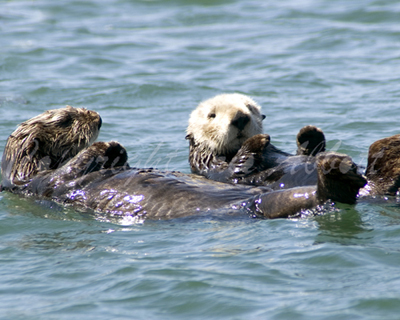
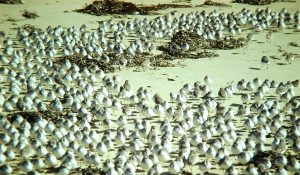 Morro Bay also has an excellent wildlife museum to help fill gaps in our knowledge about the creatures all around; we were thus able to enjoy watching an amazing variety of bird and sea life: some 250 species of birds are to be seen in the area, and we had even had to get a bigger and better bird book! We loved to watch the massed arrays of tiny plovers rushing up and down the beach as the sea washed in and out.
Morro Bay also has an excellent wildlife museum to help fill gaps in our knowledge about the creatures all around; we were thus able to enjoy watching an amazing variety of bird and sea life: some 250 species of birds are to be seen in the area, and we had even had to get a bigger and better bird book! We loved to watch the massed arrays of tiny plovers rushing up and down the beach as the sea washed in and out.
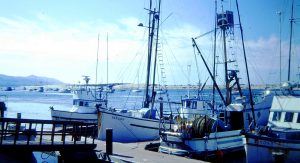 We took the bus into nearby San Luis Obispo, and toured the old mission and other sights in this pleasant little town. I was picked up by my traffic injury research colleague Phil Hight, and we flew from LA (where he and Joan live) to San Antonio, Texas, for an international conference. I was the first participant in this prominent annual meeting to have attended by boat!
We took the bus into nearby San Luis Obispo, and toured the old mission and other sights in this pleasant little town. I was picked up by my traffic injury research colleague Phil Hight, and we flew from LA (where he and Joan live) to San Antonio, Texas, for an international conference. I was the first participant in this prominent annual meeting to have attended by boat!
Meanwhile, using fabric she had bought in Sausalito, Norma completely reupholstered the cabin furniture in the boat. This was a harder job than she remembered doing it originally! She suffered through a very windy period while I was away, with several yachts dragging anchor and one even coming into contact (without causing damage).
After this very pleasant and interesting two-week stopover, with lots of socialising, we were off again, south to Los Angeles. This took only a couple of days and a night, but included rounding notorious Point Conception, one of the many “Cape Horns” of the world. Down towards the point it did blow very strongly, as advertised, and as we howled along with a strong following wind we were mighty glad we were not going the other way. While gale warnings were being broadcast we surged round the cape at well over hull speed, hand steering under a press of sail and enjoying that rare phenomenon, a brisk wind up our tail! The wind died the following dawn and we motored into frightening fog, using the navsat to grope between the shoaling shores of the Santa Barbara Channel and the busy shipping lanes just outside us - not to speak of the hordes of oil rigs.
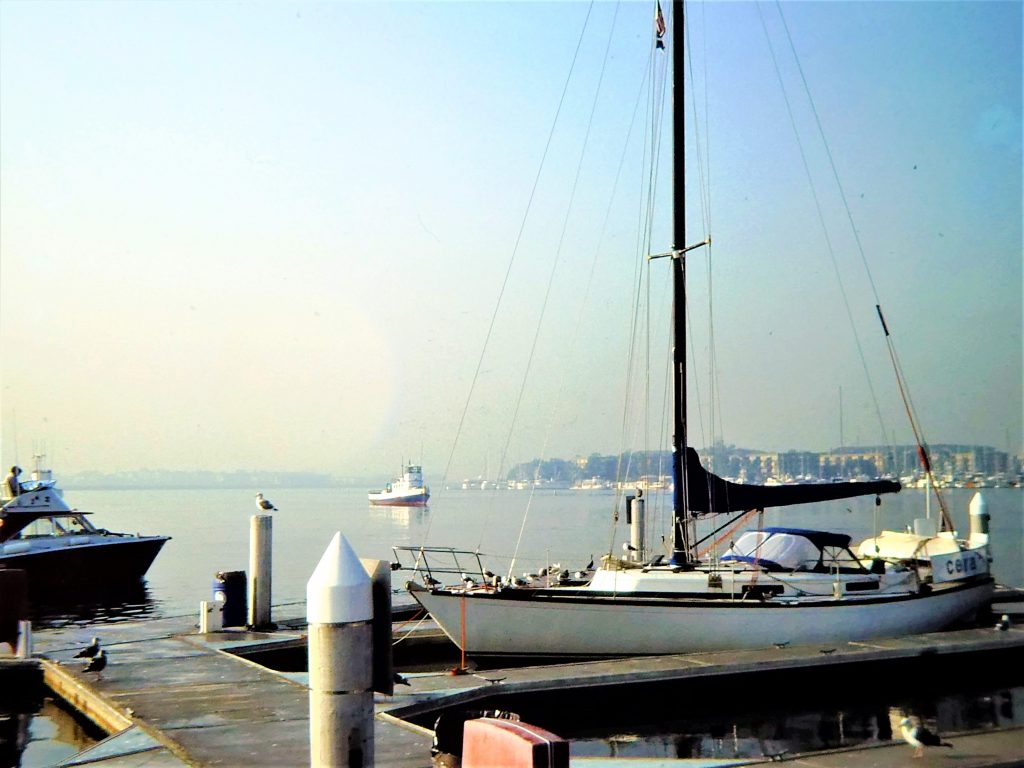
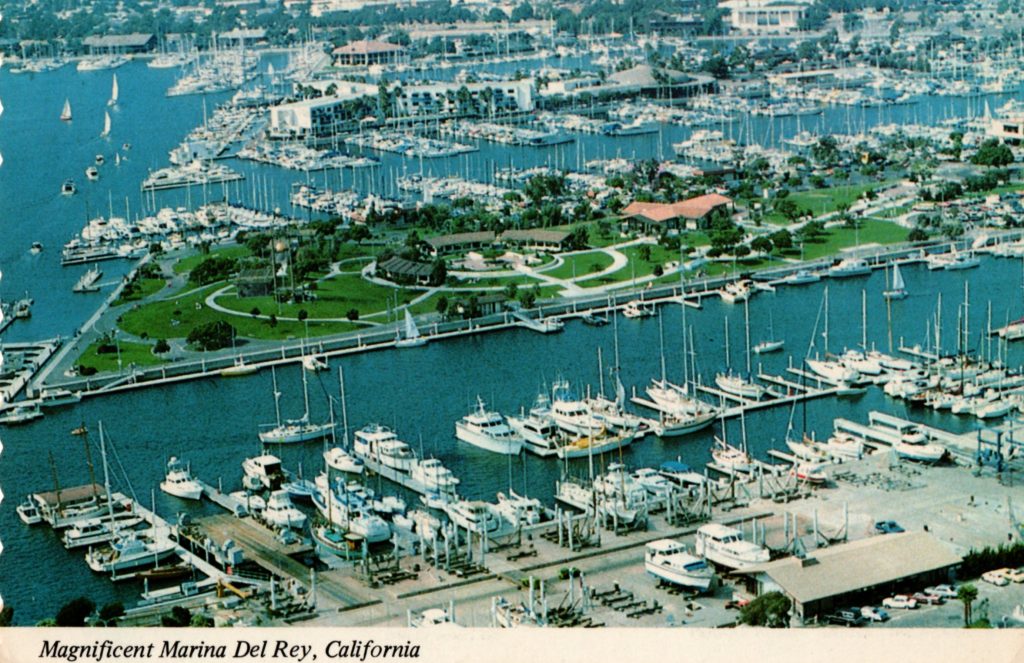 Once you get there the coast of southern California is a pretty windless place, and we motored most of the rest of the way to the Marina Del Rey in Los Angeles. The guest berth at the Santa Monica YC was full, so after a long chat with the harbourmaster we were directed to the excellent visitors’ docks at a reasonable charge but limited to a week. Fortunately the many yacht clubs in this immense marina recognised our Sydney club membership for the purpose of reciprocity, giving three days free then charging. Because the Marina del Rey is so huge it does not have the hemmed-in feeling of smaller marinas (they run small boat races entirely within it).
Once you get there the coast of southern California is a pretty windless place, and we motored most of the rest of the way to the Marina Del Rey in Los Angeles. The guest berth at the Santa Monica YC was full, so after a long chat with the harbourmaster we were directed to the excellent visitors’ docks at a reasonable charge but limited to a week. Fortunately the many yacht clubs in this immense marina recognised our Sydney club membership for the purpose of reciprocity, giving three days free then charging. Because the Marina del Rey is so huge it does not have the hemmed-in feeling of smaller marinas (they run small boat races entirely within it).
We had the use of Phil Hight's car (a Mercedes two-door coupe, no less!), which is virtually essential in this city of the automobile, and made the most of LA, doing an enjoyable round of touring, movies, theatres, shopping and the like – the last chance for a while.
Two memorable events were the Polish film “Danton”, exploring the relationship between Danton and Robespierre in a way that deliberately exposed parallels in Poland between Walesa and Jaruzelski; and “Beethoven’s Tenth”, Peter Ustinov’s latest unlikely story about Beethoven reincarnate (with a hearing aid!), made magic by Ustinov’s own masterly stage presence. To our great surprise we found pleasure in walking the streets of downtown LA; the modern architecture has immense impact because, unusually these days, the buildings are set far enough 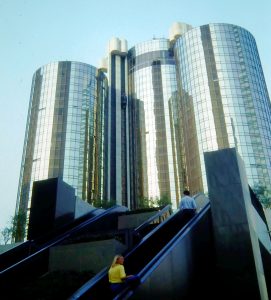 apart to see
apart to see 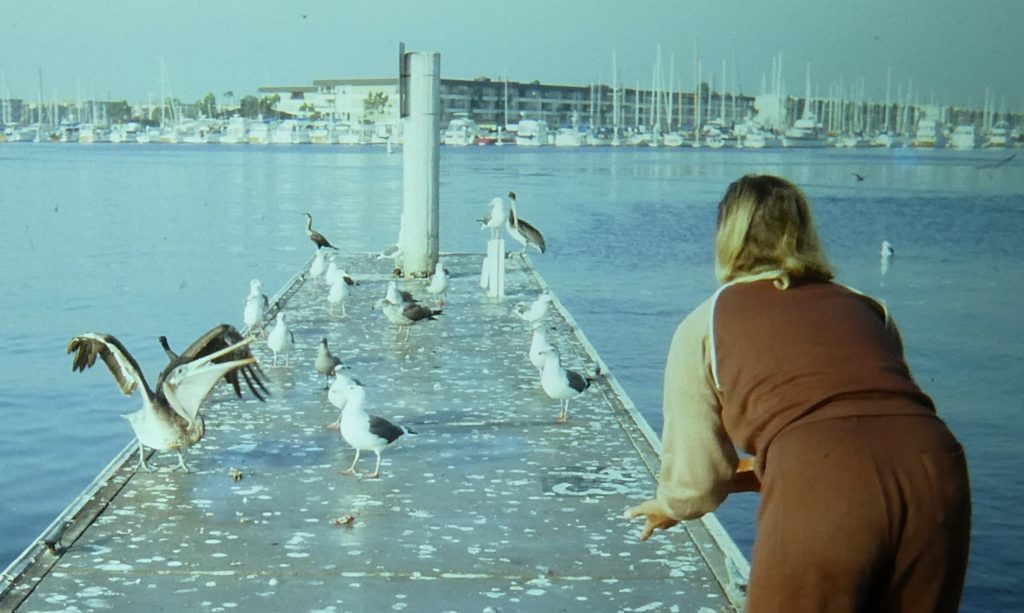 them properly. The Bonaventure Hotel is literally a modern marvel, an astonishing melange of water, flying galleries, glass, colour – a living museum of modern art, and a headshaking contrast to the grand old Biltmore, the epitome of US Colonial/Spanish architecture only a few hundred yards away.
them properly. The Bonaventure Hotel is literally a modern marvel, an astonishing melange of water, flying galleries, glass, colour – a living museum of modern art, and a headshaking contrast to the grand old Biltmore, the epitome of US Colonial/Spanish architecture only a few hundred yards away.
We both drove down to another traffic injury conference in San Diego, doing a little sightseeing each way. In particular, Mission San Juan Capistrano featured some lovely old buildings.
This had been a very busy and valuable ten days, but we had to get going again. The sail down to Mission Bay, just north of San Diego, was yet another overnighter, with just enough wind to keep us sailing most of the way. Mission Bay is a man-made harbour, dredged 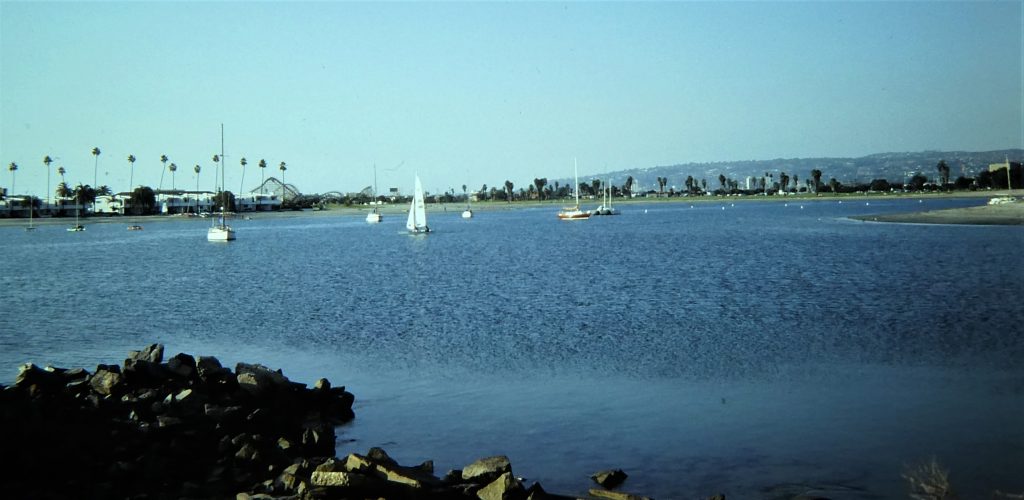 from a swamp, with some big marinas and a vast system of waterways suitable only for small-boat sailing and water-skiing, most of them being blocked off by a road bridge. The harbourmaster told us we were the only Australian yacht to enter the harbour in living memory. The only yacht anchorage is protected and pleasant enough, but is strictly limited to 72 hours and policed by an official patrol boat every night.
from a swamp, with some big marinas and a vast system of waterways suitable only for small-boat sailing and water-skiing, most of them being blocked off by a road bridge. The harbourmaster told us we were the only Australian yacht to enter the harbour in living memory. The only yacht anchorage is protected and pleasant enough, but is strictly limited to 72 hours and policed by an official patrol boat every night.
After our 72 hours we drifted in light winds (after a few days of a hot Santa Ana) round to San Diego Harbour proper, through several lobster traps and waving fields of long kelp. We made for the big yacht basin behind Shelter Island. This encloses among many other marinas including that of the San Diego Yacht Club and figures in most postcard scenes of the city (which is actually many miles away, on the other side of San Diego Harbour). To start with we could stay for a while at the "police docks", strictly for short-term use by cruising yachts.
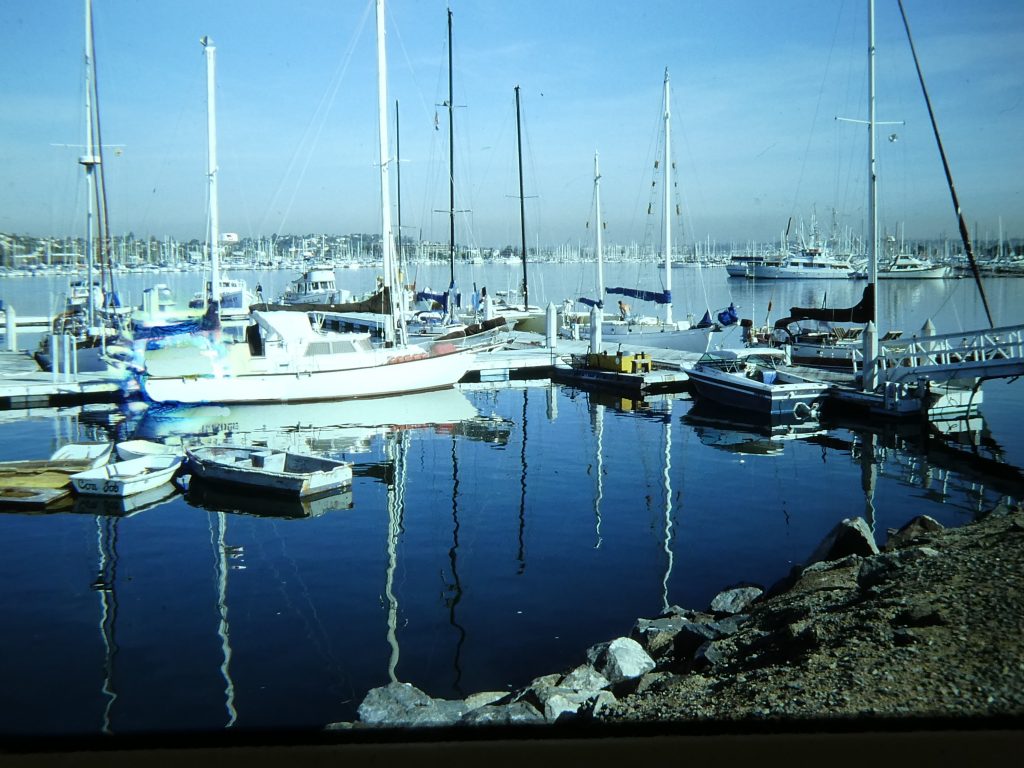 And so we started what is known among cruising yachts as the “San Diego Shuffle!” The paradox of this place is that although it must be among the world’s best places to keep, outfit and stock a yacht, it is one of the worst for the accommodation of visiting craft. This, despite the fact that virtually every vessel, power and sail, which is passage-making south to Mexico for the winter will call in there for supplies and maintenance. There is only one public dock for visitors, far from cheap and strictly limited to ten days total, and miles away from shops; our folding bikes were a blessing here. All the yacht clubs charge heavily, and generally limit the visitor to three days or so during weekdays only. Anchoring in a limited number of places was limited to 72 hours. Dinghies left on the beaches were likely to be impounded, and yachts anchored without a light at night or showing a black ball by day were fined. We initially found a guest berth at the posh and quite expensive South Western YC, but it was in a convenient position. Later, we moved to the San Diego YC, back to the police dock, and out again to the Silver Gate YC. Membership of the Royal Sydney Yacht Squadron was really paying off.
And so we started what is known among cruising yachts as the “San Diego Shuffle!” The paradox of this place is that although it must be among the world’s best places to keep, outfit and stock a yacht, it is one of the worst for the accommodation of visiting craft. This, despite the fact that virtually every vessel, power and sail, which is passage-making south to Mexico for the winter will call in there for supplies and maintenance. There is only one public dock for visitors, far from cheap and strictly limited to ten days total, and miles away from shops; our folding bikes were a blessing here. All the yacht clubs charge heavily, and generally limit the visitor to three days or so during weekdays only. Anchoring in a limited number of places was limited to 72 hours. Dinghies left on the beaches were likely to be impounded, and yachts anchored without a light at night or showing a black ball by day were fined. We initially found a guest berth at the posh and quite expensive South Western YC, but it was in a convenient position. Later, we moved to the San Diego YC, back to the police dock, and out again to the Silver Gate YC. Membership of the Royal Sydney Yacht Squadron was really paying off.
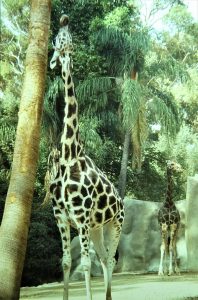 We did the sights of San Diego, including the famous zoo and the maritime museum. An early visitor to the boat was Alan Nahum, a Professor of Surgery long well known in crash research. I asked him to take a look at a sore on Norma’s face, close by her nose, which had been worrying us for a while. He arranged for us to see his partner, an international expert on the surgery of facial cancer. Confirmed as having a basal cell carcinoma, Norma had to undergo two painful sessions of outpatient surgery before it was all removed, having spread under the skin. The surgeon had to take about an inch of cheek eventually, but did a miraculous job of plastic surgery in cobbling it all together. During this period, and for shopping and limited tourism in their car, the help of our friends John and Clydie Connolly, with son Ian, was beyond value.
We did the sights of San Diego, including the famous zoo and the maritime museum. An early visitor to the boat was Alan Nahum, a Professor of Surgery long well known in crash research. I asked him to take a look at a sore on Norma’s face, close by her nose, which had been worrying us for a while. He arranged for us to see his partner, an international expert on the surgery of facial cancer. Confirmed as having a basal cell carcinoma, Norma had to undergo two painful sessions of outpatient surgery before it was all removed, having spread under the skin. The surgeon had to take about an inch of cheek eventually, but did a miraculous job of plastic surgery in cobbling it all together. During this period, and for shopping and limited tourism in their car, the help of our friends John and Clydie Connolly, with son Ian, was beyond value.
We spent the best part of a day organising the paperwork necessary to take us and our yacht into Mexico. And so, in mid-November 1983, after nearly three busy and rather troublesome weeks in unwelcoming San Diego, we finally cleared the city for Cabo San Lucas, 760 miles away, looking forward once again to exploring foreign parts after so long in the New World.
Mexico
We decided to sail non-stop to Cabo San Lucas at the tip of Baja California, although there are several possible anchorages on the Baja coast. Indeed, those many American and Canadian boats for whom the cruise to Mexico was to be their dream fulfilled were intending to make full use of them. But we thought that one bit of desert would probably look much the same as another, and we knew that we would be more likely to find some wind further out. We therefore sailed some 70-100 miles offshore and indeed found a strong nor-wester, giving us the best sail we’d had on the west coast and a fast run to Cabo. On the way we re-entered tropical waters, at 23 degrees 26 minutes north latitude. We stripped off.
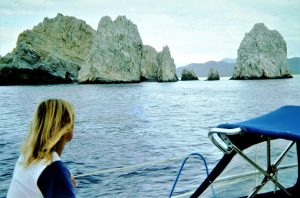 We sailed around the tip of Cabo San Lucas past the distinctive rock
We sailed around the tip of Cabo San Lucas past the distinctive rock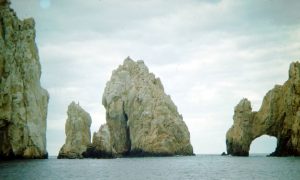 formation, the arch in the rock, or "El Arco", and rounded up into the wide-open bay off the town. The town itself straggles along behind the beach. Here in 1983 it was a simple little place catering mainly for American game fishermen who, with their families, were staying in one of the few posh hotels while boat boys and crew looked after their boats. Most of the game boats lay to moorings in the bay off the scruffy Mexican township, and the only available space left to anchor when we arrived was very close to the beach because it was too deep further out.
formation, the arch in the rock, or "El Arco", and rounded up into the wide-open bay off the town. The town itself straggles along behind the beach. Here in 1983 it was a simple little place catering mainly for American game fishermen who, with their families, were staying in one of the few posh hotels while boat boys and crew looked after their boats. Most of the game boats lay to moorings in the bay off the scruffy Mexican township, and the only available space left to anchor when we arrived was very close to the beach because it was too deep further out.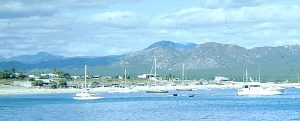 There was a small harbour - one day to be developed into a marina - where anchoring was possible, but it was packed out. Our anchorage off the south-facing beach was fearfully rolly in the swell and wide open to the sea. All the big game-fishing boats were running their noisy generators.
There was a small harbour - one day to be developed into a marina - where anchoring was possible, but it was packed out. Our anchorage off the south-facing beach was fearfully rolly in the swell and wide open to the sea. All the big game-fishing boats were running their noisy generators.
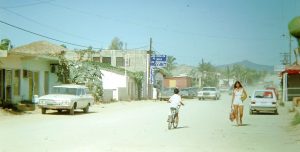 Going ashore in the dinghy, we completed some bureaucratic procedures and had a walk into the town along the (then) only paved road. We did some basic shopping in the basic shops, the buildings all looking typical for a smal Mexican town in the period. We had a good, cheap lunch with plenty of excellent cerveza. The wind was from the north, which would have been great to keep going, but we needed both fuel and water as well as supplies. We collected the water in the surreal surroundings of the disused and rusting remains of an old fish cannery.
Going ashore in the dinghy, we completed some bureaucratic procedures and had a walk into the town along the (then) only paved road. We did some basic shopping in the basic shops, the buildings all looking typical for a smal Mexican town in the period. We had a good, cheap lunch with plenty of excellent cerveza. The wind was from the north, which would have been great to keep going, but we needed both fuel and water as well as supplies. We collected the water in the surreal surroundings of the disused and rusting remains of an old fish cannery.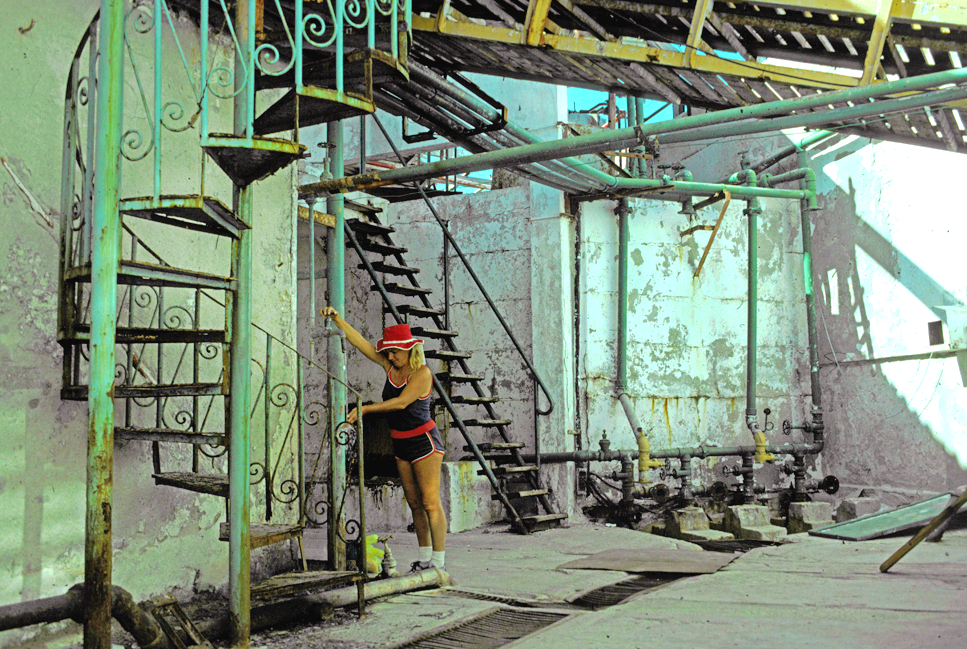
After an comfortable two nights we cleared with the bureaucracy to leave, but meanwhile the wind had swung into the south-east, bringing a big swell into the anchorage. Exactly a year previously, a southerly gale had ripped through just where we lay, and driven some 30 boats ashore as they dragged anchor. These included Bernard Moitessier's famous ketch, Joshua. We had long been avid readers of Moitessier's writings, including his philosophy of ocean sailing and practical approaches to yacht handling in extremes of weather. The story we heard was that he and his single temporary crewman had been ashore drinking at a hotel, and by the time he realised that his yacht was in danger it was too late. Joshua dragged sideways on to the beach, along with many others. He "gave" her away for $20, thinking she could not be salvaged, but she was eventually returned to France and rebuilt.
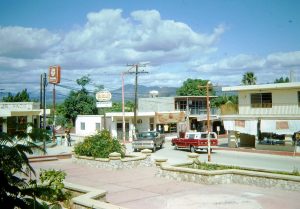 The southerly wind we were facing picked up to the extent that we had surf each side of us, and after a very uncomfortable night we pulled out of this roadstead and made for the inner harbour, where we secured the last available space to anchor. But first, we had had to wait for the ferry to leave; the inner harbour was small, packed, and practically everyone was having to move out twice a week to give the ferry manoeuvring space. We spent the night there after a big party in the evening, enjoying the company of many American yachties celebrating Thanksgiving.
The southerly wind we were facing picked up to the extent that we had surf each side of us, and after a very uncomfortable night we pulled out of this roadstead and made for the inner harbour, where we secured the last available space to anchor. But first, we had had to wait for the ferry to leave; the inner harbour was small, packed, and practically everyone was having to move out twice a week to give the ferry manoeuvring space. We spent the night there after a big party in the evening, enjoying the company of many American yachties celebrating Thanksgiving.
Four days were quite enough for us at Cabo. When clearing out an official tried to hit us for $5 for a nominally free permit to take the boat across to the Mexican “mainland”, but backed off when I asked him for a receipt. He said, ”well, if you don’t want to pay . . .”. Looking over the shoulder of a young American girl writing a postcard in the Post Office, I saw she described the place as “a paradise”. Ho hum.
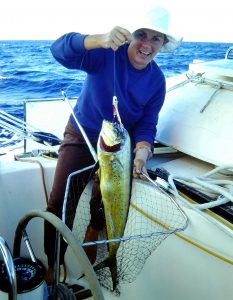 We were away early the next day in a clear morning and a favourable wind. Within a couple of hours we had caught a good dorado. Sailing on, we had a pleasant close reach in light airs over to the Mexican “mainland”, making for the small protected harbour at Puerto Vallarta. We had decided to pass by what was reported to be good cruising in the Sea of Cortez, because to do it justice would have taken more time than we could spare, if we were to stick to our aim of clearing the western Caribbean before the beginning of the 1984 Atlantic hurricane season. Long distance cruising does have its deadlines, long term though they may be!
We were away early the next day in a clear morning and a favourable wind. Within a couple of hours we had caught a good dorado. Sailing on, we had a pleasant close reach in light airs over to the Mexican “mainland”, making for the small protected harbour at Puerto Vallarta. We had decided to pass by what was reported to be good cruising in the Sea of Cortez, because to do it justice would have taken more time than we could spare, if we were to stick to our aim of clearing the western Caribbean before the beginning of the 1984 Atlantic hurricane season. Long distance cruising does have its deadlines, long term though they may be!
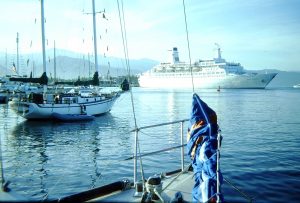 Puerto Vallarta harbour is man-made, but like everything else in Mexico it was still unfinished. A turning circle for the cruise ships had to be kept clear, so cruising yachts had to squeeze in between the turning circle and a small marina that is full up with local boats. There is no room to swing to anchor, so the four boats including us that were there at the time tied stern-to to trees in the grounds of a naval base, where we were entertained each morning by the world’s worst bugle band. The first night there was the most peaceful we'd had since leaving San Diego. We took the dinghy up a creek beyond the anchorage, where substantial clearing was under way for the building of a big marina.
Puerto Vallarta harbour is man-made, but like everything else in Mexico it was still unfinished. A turning circle for the cruise ships had to be kept clear, so cruising yachts had to squeeze in between the turning circle and a small marina that is full up with local boats. There is no room to swing to anchor, so the four boats including us that were there at the time tied stern-to to trees in the grounds of a naval base, where we were entertained each morning by the world’s worst bugle band. The first night there was the most peaceful we'd had since leaving San Diego. We took the dinghy up a creek beyond the anchorage, where substantial clearing was under way for the building of a big marina.
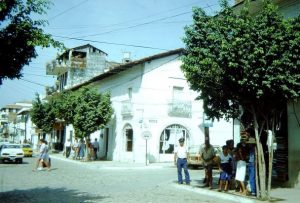 Puerto Vallarta itself relies on tourist income, from the cruise ships which amazingly squeezed into the tiny harbour quite close to us, and from holidaying gringos at time-sharing condos and the smart hotels that fringe the sea front between the harbour and the town. We rode the local bus into town, an experience in itself, and had a nightmarish ride on the way back with armloads of stores as the packed bus rattled over the cobbled streets in boiling heat.
Puerto Vallarta itself relies on tourist income, from the cruise ships which amazingly squeezed into the tiny harbour quite close to us, and from holidaying gringos at time-sharing condos and the smart hotels that fringe the sea front between the harbour and the town. We rode the local bus into town, an experience in itself, and had a nightmarish ride on the way back with armloads of stores as the packed bus rattled over the cobbled streets in boiling heat.
The town was pleasant and generally very pretty, and actually quite fun on a non-cruise-ship day, when the shops were quieter and the craftwork prices lower. This was one of those places where we wished we had more money and a boat with more room for storage, because we thought the art and craft goods were brilliant. This is true for all Mexico, but we did not realise at that time that there is great regional variation; we saw things in Puerto Vallarta which we thought we might get more cheaply further south, but 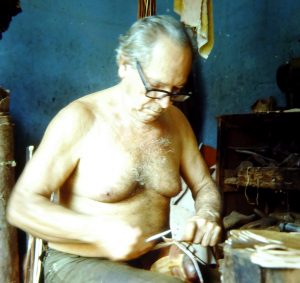
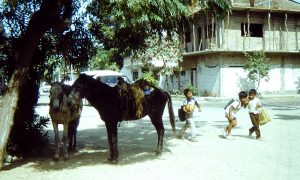 we never saw them again. Prices for top-quality art were not low – several hundreds of dollars for work by such as Sergio Bustamente – but for general consumer goods, with the low value of the Mexican peso against the dollar, the prices we thought to be very low. This also applied to local services such as buses and trains. Touristy activities, such as renting a car or flying, were very expensive. But to live like the locals, as we were generally doing, was to live very cheaply. Another yachty tipped us off that we could get a free lunch at a nearby condo, where they were selling time-share units. We sat out the sales pitch and had a burger and a 500ml bottle of Kahlua!
we never saw them again. Prices for top-quality art were not low – several hundreds of dollars for work by such as Sergio Bustamente – but for general consumer goods, with the low value of the Mexican peso against the dollar, the prices we thought to be very low. This also applied to local services such as buses and trains. Touristy activities, such as renting a car or flying, were very expensive. But to live like the locals, as we were generally doing, was to live very cheaply. Another yachty tipped us off that we could get a free lunch at a nearby condo, where they were selling time-share units. We sat out the sales pitch and had a burger and a 500ml bottle of Kahlua!
This was a good place to sit tight for a little while and to get the boat cleaned, sorted, write letters and Christmas cards. Norma fixed up the sails, and we walked a lot round the town and its environs. We came to like Puerto Vallarta a lot, even if many buildings looked unfinished and most shops were out of some stuff or other. We had an interesting visit by two local fishermen, who were amazed that we had sailed so far with just the two of us aboard. They commented that it took at least six Mexicans to take a boat out of the harbour! Telling us about their catch, they called shark "sea trout", and told us that stingrays are sold to Santa Monica. There, they are chopped up with a cookie-cutter, with the discs of flesh sold as "scallops". We have been conscious of this scam ever since, and insist that we only buy or eat scallops that have their roe on.
After nearly three weeks there quite a community of friends was established, but it was time to get going again. As it happened, a hurricane had been wandering around between Manzanillo and Acapulco, and there was no rush - indeed, the Port Captain was reluctant to clear us out until we convinced him that we would keep a close eye on the weather on our way south.
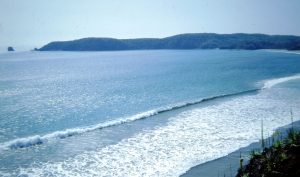 We sailed out of the huge bay at the head of which lies Puerto Vallarta, and then turned south down the coast to a rather smaller bay, Bahia Tenacatita, an overnight sail. The fishing was good, catching two tuna but losing an angry wahoo. The boobies were a nuisance, diving for our lures and having to be retrieved and unhooked. They did not like this process, and flew up on the rigging, grumbling.
We sailed out of the huge bay at the head of which lies Puerto Vallarta, and then turned south down the coast to a rather smaller bay, Bahia Tenacatita, an overnight sail. The fishing was good, catching two tuna but losing an angry wahoo. The boobies were a nuisance, diving for our lures and having to be retrieved and unhooked. They did not like this process, and flew up on the rigging, grumbling.
We were pleased that the bay was not adjacent to any town of any size, and that for the first time for months we had a place to ourselves for anchorage. The north-western end of the bay, where we lay, is fringed by jungle, and further round the bay there were a few condos and hotels to be seen. This is a sheltered bay by Mexican standards, but even so it was subject to the swell which it is always hard to avoid on this coast. It did get calmer at night.
We took the long overdue opportunity to snorkel dive and rub clean the bottom of the boat, and get stuck into the excellent fishing: two huge trevally the second day, enough for six meals. Masses of pelicans were diving all around us, and we saw lots more large birds on a dinghy trip up a little river that entered the bay near us. By this time the weather was lovely, with beautiful sunsets in perfect temperatures.
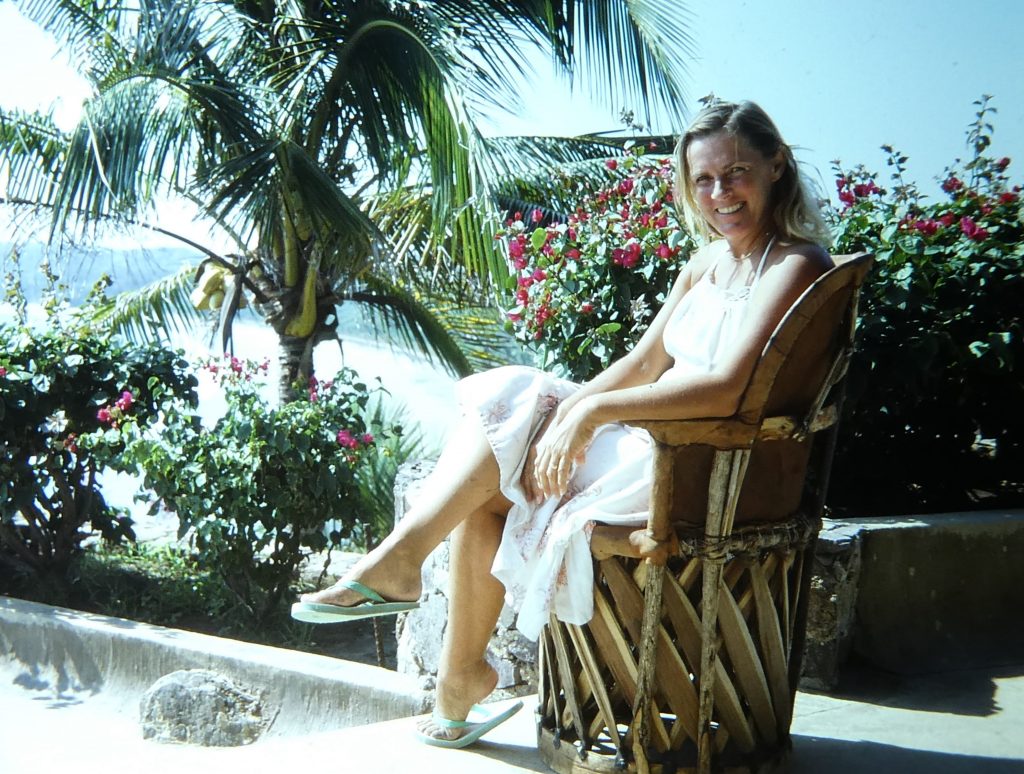 Ashore, we walked round to the buildings further round the bay. We had a long Mexican "afternoon lunch" at the Hotel Los Angeles there, with a gorgeous outlook. It was practically deserted but served excellent octopus and ceviche fish by the pool. To one side of it was another hotel, but abandoned, and to the other side, with business logic which escaped us, some investor was building yet another huge hotel complex! Soon, it seemed to us, every beach on the Mexican coast would have a hotel behind it, and rooms would be even harder to fill.
Ashore, we walked round to the buildings further round the bay. We had a long Mexican "afternoon lunch" at the Hotel Los Angeles there, with a gorgeous outlook. It was practically deserted but served excellent octopus and ceviche fish by the pool. To one side of it was another hotel, but abandoned, and to the other side, with business logic which escaped us, some investor was building yet another huge hotel complex! Soon, it seemed to us, every beach on the Mexican coast would have a hotel behind it, and rooms would be even harder to fill.
After a peaceful four nights we sailed away again for our next stop, the commercial port of Manzanillo, which we reached during the day. Fairly typically for this part of the coast of Mexico we motored for about a third of the time, or half the distance.
 Manzanillo Bay is a big expanse of water with a hotel and resort complex on a peninsula near the middle and the city harbour, enclosed by a breakwater, at southern end. Like many boats we first anchored in the bay off the resort for a while. There is also a marina for those who can afford it. Las Hadas, as the resort is known, is an extraordinary jumble of whitewashed buildings, an ersatz mix of Spanish and Moorish architecture. The resort imposed a charge of $4 a day for anchored yachts to “use the facilities”, which would have made a swim in the pool pretty expensive; and as we couldn’t even get ashore to the shops without going through the resort (and having to show a pass to get back in!), we moved over to anchor in the main town harbour.
Manzanillo Bay is a big expanse of water with a hotel and resort complex on a peninsula near the middle and the city harbour, enclosed by a breakwater, at southern end. Like many boats we first anchored in the bay off the resort for a while. There is also a marina for those who can afford it. Las Hadas, as the resort is known, is an extraordinary jumble of whitewashed buildings, an ersatz mix of Spanish and Moorish architecture. The resort imposed a charge of $4 a day for anchored yachts to “use the facilities”, which would have made a swim in the pool pretty expensive; and as we couldn’t even get ashore to the shops without going through the resort (and having to show a pass to get back in!), we moved over to anchor in the main town harbour.
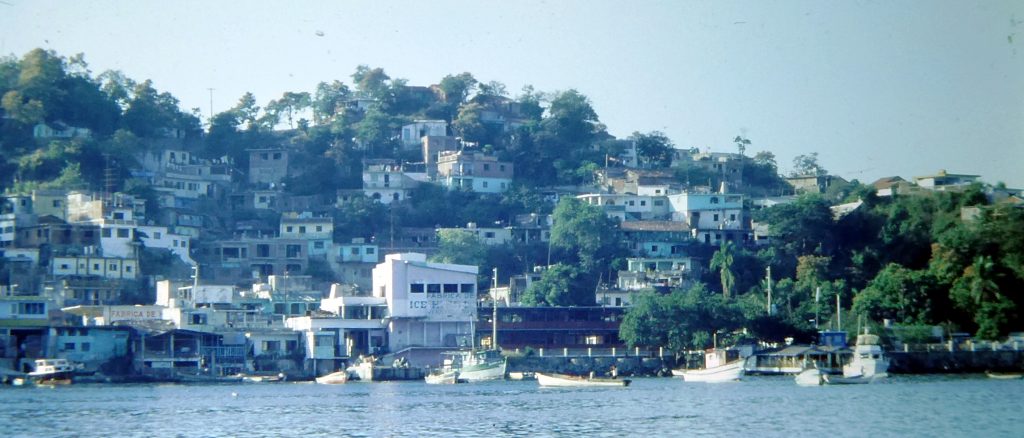 Manzanillo is a busy working port, and as such is dirty and noisy; but, free of the tourists who are the raison d’etre for most coastal towns in Mexico, it is also free of the pretensions which go with tourism. The market was excellent (in general, fresh produce throughout the whole country was abundant and first class) and the prices generally the lowest we found in Mexico.
Manzanillo is a busy working port, and as such is dirty and noisy; but, free of the tourists who are the raison d’etre for most coastal towns in Mexico, it is also free of the pretensions which go with tourism. The market was excellent (in general, fresh produce throughout the whole country was abundant and first class) and the prices generally the lowest we found in Mexico.
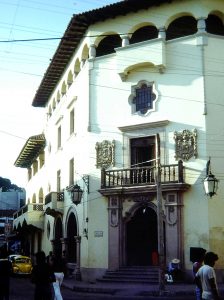 Here is a typical morning in Mexico, as recorded in the log. First, to the bank, where after
Here is a typical morning in Mexico, as recorded in the log. First, to the bank, where after  two lots of queuing and a great deal of typing by bored clerks we managed to cash some travellers’ cheques. The next battle was with the Post Office, where the clerk refused to sell us (or anybody else) stamps because he had run out of change! Then to the Port Captain’s building, where we solemnly trotted up and down stairs between his office and that of the Immigration Department, at the same time clearing both into and out of the port. What a pantomime! But meanwhile we did some good, cheap shopping for some clothes, food and drinks.
two lots of queuing and a great deal of typing by bored clerks we managed to cash some travellers’ cheques. The next battle was with the Post Office, where the clerk refused to sell us (or anybody else) stamps because he had run out of change! Then to the Port Captain’s building, where we solemnly trotted up and down stairs between his office and that of the Immigration Department, at the same time clearing both into and out of the port. What a pantomime! But meanwhile we did some good, cheap shopping for some clothes, food and drinks.
And so onward south down the coast to Acapulco, and after three days at sea arriving the day before Christmas Eve in time to do some Christmas shopping. Acapulco Bay is huge and backed by an impressive range of mountains. The only practical anchorage is off the Acapulco Yacht Club. This has some expensive stern-to berths on the outer face of its marina, where surge is a substantial 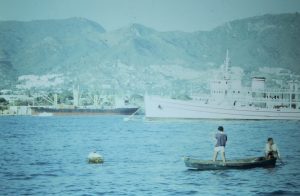 problem; we chose to try to find a space to anchor among the several unoccupied moorings scattered throughout the best area. The club really caters for rich Mexicans from Mexico City and free-spending gringos with game boats, rather than impecunious cruising yachties. They had the gall to charge visiting boats over double the going rate for diesel fuel, so once again we ferried the stuff to the boat in jerry cans from a convenient service station across the bay.
problem; we chose to try to find a space to anchor among the several unoccupied moorings scattered throughout the best area. The club really caters for rich Mexicans from Mexico City and free-spending gringos with game boats, rather than impecunious cruising yachties. They had the gall to charge visiting boats over double the going rate for diesel fuel, so once again we ferried the stuff to the boat in jerry cans from a convenient service station across the bay.
As usual we usually ate well when "out" in Mexico, and did so for lunch this first day at a waterfront restaurant: hot chili rellenos, pollo mole, guacamole, melted cheese. (During our stay we enjoyed the street food too, and had absolutely no stomach problems at all. But - later on, one evening we were taken out to dinner at a posh hotel by an American tourist who befriended us, with very unpleasant results for the first time in Mexico . . .)
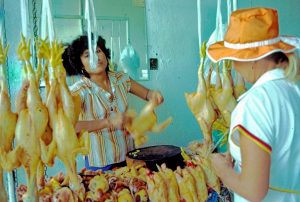 On the boat for Christmas Eve we were buzzed by happy Mexicans water skiing, having fun at the start of the holiday season. But it was quiet that night and on the morning of Christmas Day, our third while living on the boat. Christmas dinner featured an excellent, tasty and tender chicken we had bought at the local market. We bought Christmas decoration hangings for the boat (which we still hang at home now).
On the boat for Christmas Eve we were buzzed by happy Mexicans water skiing, having fun at the start of the holiday season. But it was quiet that night and on the morning of Christmas Day, our third while living on the boat. Christmas dinner featured an excellent, tasty and tender chicken we had bought at the local market. We bought Christmas decoration hangings for the boat (which we still hang at home now).
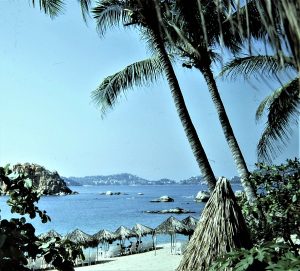 Acapulco Bay extends from the end where the yacht club lies among some run-down hotels, via the old downtown commercial
Acapulco Bay extends from the end where the yacht club lies among some run-down hotels, via the old downtown commercial 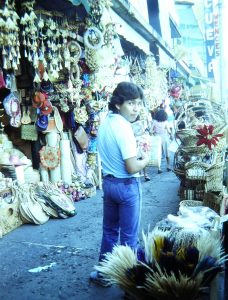 centre, to the Acapulco featured on all the postcards at the other end. Here are the immense Hyatts, Intercontinentals and Marriotts, where tourists lie poolside in the sun. Downtown “old” Acapulco is another world, one which most tourists avoid: a hot, noisy bedlam of packed pavements and loony drivers, where food and all supplies are cheap and plentiful for those with enough stamina to stand the pace of obtaining them. It was a fast, rough bus ride from the yacht club into town, and as few mechanical devices can be made sturdy enough to survive Mexico the bell pulls are usually broken. The only way to stop the bus is to bang on the roof. However, it is hazardous in the extreme to attempt to stand up to do so.
centre, to the Acapulco featured on all the postcards at the other end. Here are the immense Hyatts, Intercontinentals and Marriotts, where tourists lie poolside in the sun. Downtown “old” Acapulco is another world, one which most tourists avoid: a hot, noisy bedlam of packed pavements and loony drivers, where food and all supplies are cheap and plentiful for those with enough stamina to stand the pace of obtaining them. It was a fast, rough bus ride from the yacht club into town, and as few mechanical devices can be made sturdy enough to survive Mexico the bell pulls are usually broken. The only way to stop the bus is to bang on the roof. However, it is hazardous in the extreme to attempt to stand up to do so.
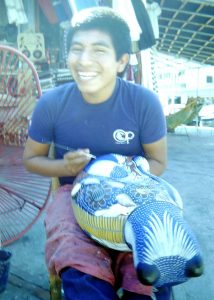 We did find much of our time in Mexico rather heavy going, and a sense of humour was required - albeit sometimes hard to maintain. I think what really got to us was the vast amount of unproductive activity one sees around the place. On the one hand one might (read does) see a big new hotel being built right alongside two others which have just gone broke because nobody wants to stay there. On the other, government offices are packed with morose men and women for whom our necessary intrusions on their time were clearly unwelcome disturbances which upset the even tenor of the day. One lady (in the Customs office in Acapulco) said we would have to fill in five copies of a form. Fine, says I, give me five blanks and let me do it. No, says she, giving me one – and sending me across the street to the shopfront Xerox to get four photocopies. On return she solemnly interleaved this lot with carbon paper – then filled them in!
We did find much of our time in Mexico rather heavy going, and a sense of humour was required - albeit sometimes hard to maintain. I think what really got to us was the vast amount of unproductive activity one sees around the place. On the one hand one might (read does) see a big new hotel being built right alongside two others which have just gone broke because nobody wants to stay there. On the other, government offices are packed with morose men and women for whom our necessary intrusions on their time were clearly unwelcome disturbances which upset the even tenor of the day. One lady (in the Customs office in Acapulco) said we would have to fill in five copies of a form. Fine, says I, give me five blanks and let me do it. No, says she, giving me one – and sending me across the street to the shopfront Xerox to get four photocopies. On return she solemnly interleaved this lot with carbon paper – then filled them in!
Mexicans do everything at play with full noise and vigour. No little speed-boat will venture out without being grossly overloaded, and buzzing the anchored yachts in a blur of spray, with screams and shouts, is all part of the fun. We did consider taking the train to Mexico City, but getting the necessary bookings and tickets was such a nightmare we gave up. We didn't like the idea of leaving the boat at anchor, either.
We must move on or go mad, we thought, and turned our minds to the next major obstacle of our cruise, the crossing of the Gulf of Tehuantepec on our way down to Costa Rica. Most sailors have heard vaguely of the “Tehuantepecer”, but few who have not had to confront it realise what a fearful affair it can be. It is a northerly gale which funnels down through the Isthmus of Tehuantepec in a valley between the mountains of Mexico and Guatemala. It is driven by cold fronts moving through the Gulf of Mexico and carrying cold air which is literally falling down from the Rocky Mountains. During January and February it blows more often than not, and during Christmas in Acapulco we listened with some dismay to reports of winds of storm force, 50-70 knots with towering seas, broadcast by the American shortwave stations.
We waited for the new year before leaving. 1984 was welcomed by bomb-like Mexican fireworks, and we then faced the ponderously bureaucratic business of officially clearing the country. This involved several hot tramps between Immigration, Customs and the Port Captain, as most officials want to see all the others’ forms and put their own stamp on. A gale warning for the Gulf of Tuantepec was still current when we left on the second day of the year, but the wind seemed to be abating and we thought all would be well by the time we got to the Gulf. But the gale was reportedly continuing and so we pulled into an anchorage at the northern end of an open bay, Puerto Escondido, for a couple of days.
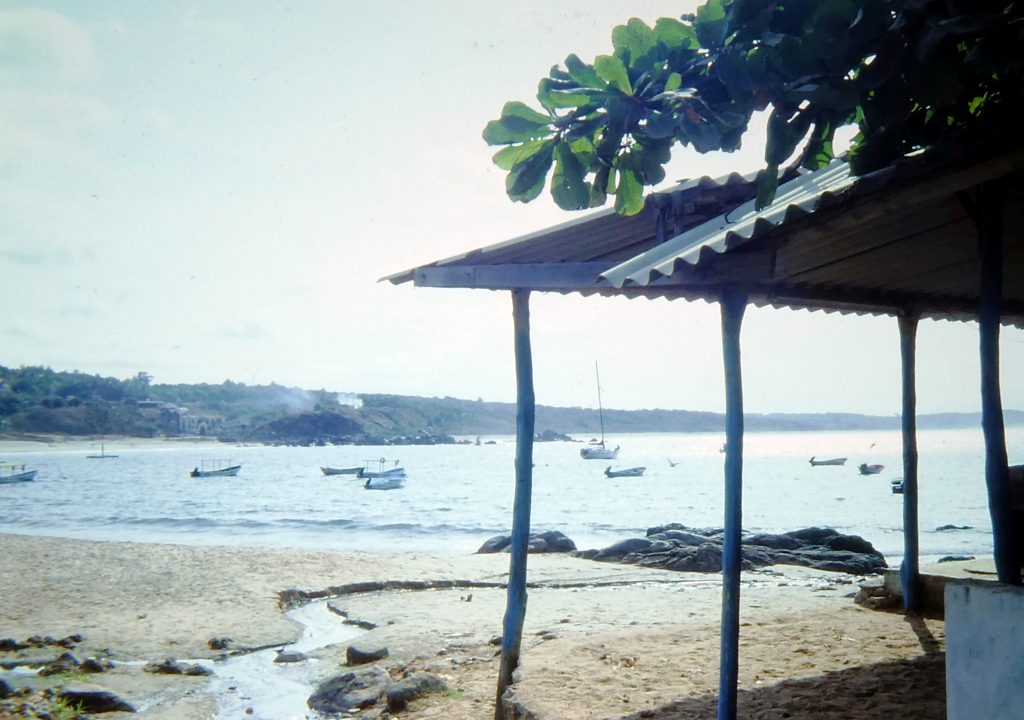 Puerto Escondido is a common name in Central America; it means “hidden port”. This particular one, in Mexico, was so well hidden it hardly existed, as Norma commented. It is simply a roadstead, with a curving beach wide open to the south. Swells were rolling up from the gales in the Gulf. Surf on the beach is an obvious sign any anchorage may be rolly, and indeed there was surf crashing on to the beach the other side of the bay from the settlement. The rolling of the boat was, indeed, appalling, and the 26 metre depth of water meant we couldn’t take a stern anchor out to hold us bow-on to the swell. To be fair, the only cruising guide available in 1983 refers to a "slight swell", but not dangerous and with no breaking water on the beach. But the conditions we faced were not so benign.
Puerto Escondido is a common name in Central America; it means “hidden port”. This particular one, in Mexico, was so well hidden it hardly existed, as Norma commented. It is simply a roadstead, with a curving beach wide open to the south. Swells were rolling up from the gales in the Gulf. Surf on the beach is an obvious sign any anchorage may be rolly, and indeed there was surf crashing on to the beach the other side of the bay from the settlement. The rolling of the boat was, indeed, appalling, and the 26 metre depth of water meant we couldn’t take a stern anchor out to hold us bow-on to the swell. To be fair, the only cruising guide available in 1983 refers to a "slight swell", but not dangerous and with no breaking water on the beach. But the conditions we faced were not so benign.
We took a quick walk ashore to check in with the authorities at the settlement and to have look at the few scruffy shops - and scruffier young tourists, many of them European; marijuana was easy to get here, and we were offered some on the boat. We slept in the saloon, lee cloths and all, as at sea, to cope with the rolling of the boat.
We couldn't stay there, but had to stop somewhere because another day's sailing would bring us to the Gulf of Tehuantapec, where the reported wind strength was currently being reported to be 40 knots from the north. The last possible stop before the Gulf was in a small bay at the village of Santa Cruz Huatulco, about 70 nautical miles further down the coast, which our experienced friends Eric and Susan Hiscock had mentioned as being a good stop. After a couple of days in Escondido we left in the evening for an overnight sail to Huatulco through a wet, windy and black night, lit only by flashes of lightning, a "trying little passage" as I remarked in the log.
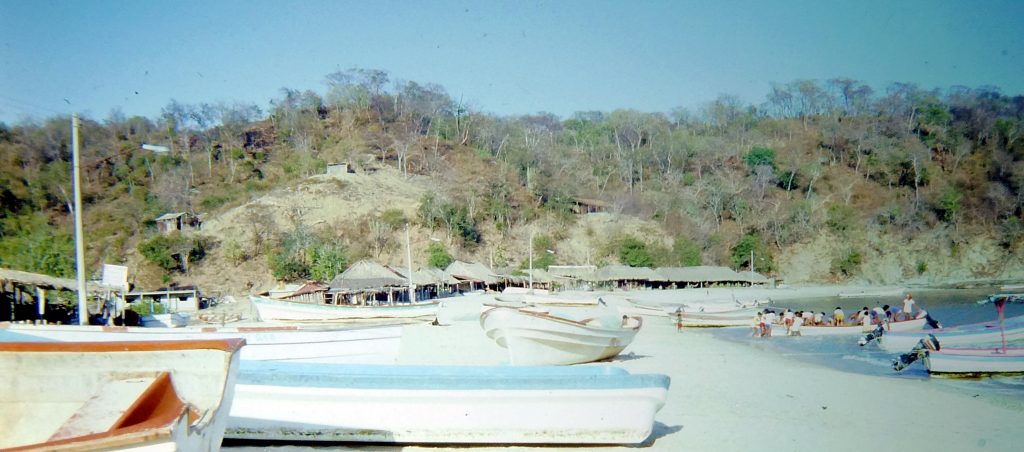 Huatulco is located in the state of Oaxaca where the foothills of the Sierra Madre del Sur mountains meet the Pacific Ocean. We came to anchor in improving weather conditions in what did indeed look like a peaceful and well-protected bay, along with one or two other yachts. A small swell was the only indication that any wind was blowing in the Gulf of Tehuantapec, a few miles to the south. After a good sleep we went ashore and had lunch at a palapa - an open thatched cafe/restaurant - on the beach with an Italian couple, a doctor and her husband. We walked
Huatulco is located in the state of Oaxaca where the foothills of the Sierra Madre del Sur mountains meet the Pacific Ocean. We came to anchor in improving weather conditions in what did indeed look like a peaceful and well-protected bay, along with one or two other yachts. A small swell was the only indication that any wind was blowing in the Gulf of Tehuantapec, a few miles to the south. After a good sleep we went ashore and had lunch at a palapa - an open thatched cafe/restaurant - on the beach with an Italian couple, a doctor and her husband. We walked 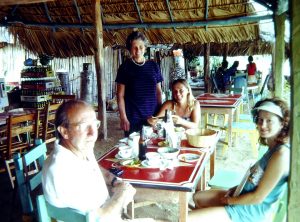 around the village and were delighted to find "traditional" Mexico: a remote fishing village, with only one road in, with simple thatched dwellings, smiling faces, donkeys, pigs, dogs, cats and chickens all wandering around. The income for the locals was clearly through the lines of palapas catering for tourists, but there were not many of them.
around the village and were delighted to find "traditional" Mexico: a remote fishing village, with only one road in, with simple thatched dwellings, smiling faces, donkeys, pigs, dogs, cats and chickens all wandering around. The income for the locals was clearly through the lines of palapas catering for tourists, but there were not many of them.
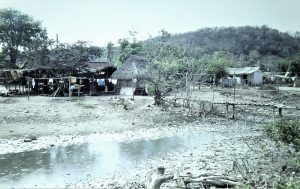 This turned out to be the best place we anchored in Mexico, and we had a very good time there, making friends with several European and American couples spending much of the northern winter in Huatulco. After a couple of days we were visited by "Vigilante" officials in a Navy boat; we had officially been "cleared out" from Acapulco and strictly speaking should not have stopped again in Mexico. But Norma chatted away in Spanish to them and they agreed that we could wait for the gales just to the south to settle down.
This turned out to be the best place we anchored in Mexico, and we had a very good time there, making friends with several European and American couples spending much of the northern winter in Huatulco. After a couple of days we were visited by "Vigilante" officials in a Navy boat; we had officially been "cleared out" from Acapulco and strictly speaking should not have stopped again in Mexico. But Norma chatted away in Spanish to them and they agreed that we could wait for the gales just to the south to settle down.
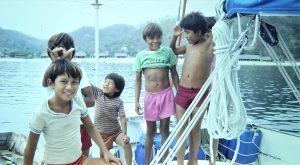 We did lots of reading and writing, work on the boat, and exploring adjacent bays and beaches in the inflatable dinghy, all very pretty. American friends took us for a run in their car to a nearby town, where we did some more serious stocking up. The weather continued to be glorious, and the gales warnings continued as well. Ten days after arriving, the normally laconic US weather broadcaster seemed impressed that gales were "continuing" in the Gulf of Tehuantepec, with 35 knot winds raising six-metre seas up to 150 nautical miles from the coast.
We did lots of reading and writing, work on the boat, and exploring adjacent bays and beaches in the inflatable dinghy, all very pretty. American friends took us for a run in their car to a nearby town, where we did some more serious stocking up. The weather continued to be glorious, and the gales warnings continued as well. Ten days after arriving, the normally laconic US weather broadcaster seemed impressed that gales were "continuing" in the Gulf of Tehuantepec, with 35 knot winds raising six-metre seas up to 150 nautical miles from the coast.
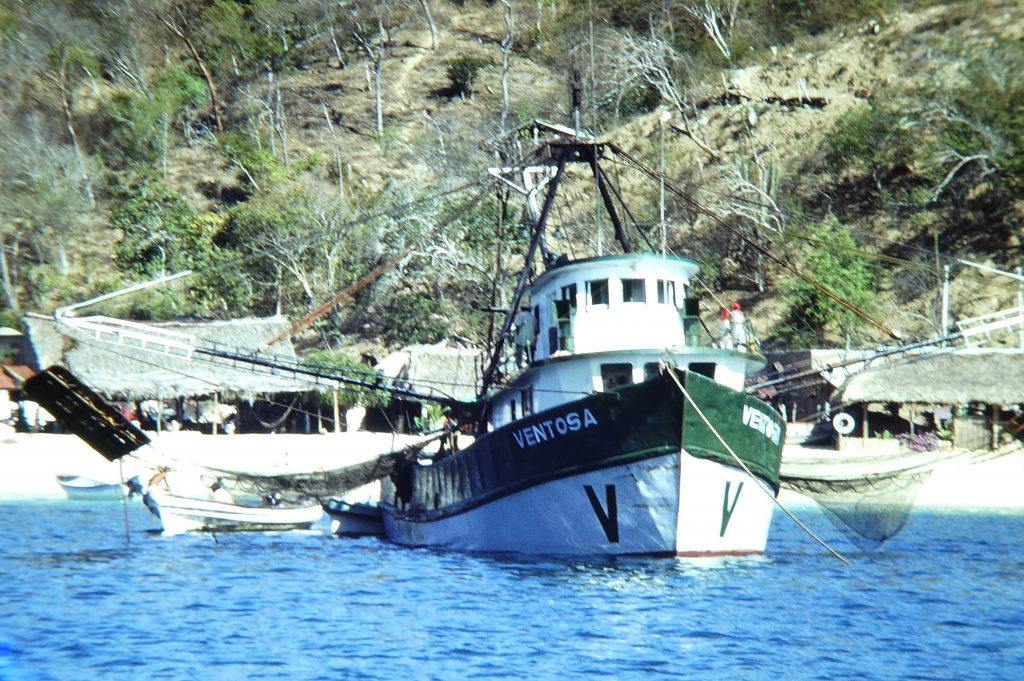
Going back to the boat one afternoon we were hailed by the crew of a visiting shrimper, the Ventosa V, and were invited by Captain Marcellino to a long boozy lunch of prawns, turtle stew, tortillas and beer. We were then invited to join them for fishing that night, which turned out to be quite an experience, as we had never gone "professional" fishing before. They were trawling for prawns at a depth of about 300 metres, and when each net-load was winched aboard we helped to sort out the prawns by colour - red and white - and behead them. We also had to sort them out from all the other weird and wonderful sea creatures, and Norma picked out some good shells for her collection. The cheerful crew worked well together and were very friendly with us. Norma's Spanish-speaking skills made all the difference. We were fed delicious fried baby snapper in the evening, and for breakfast we had mashed shark, rice, tortillas, and a superb salsa.
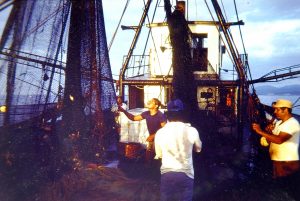
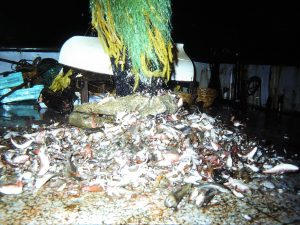
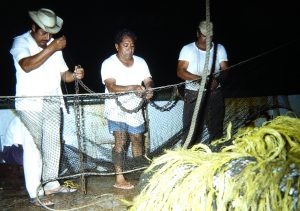
After returning in the morning with the prawns on ice, I took over a bottle of Jim Beam and treated two of the crew for minor skin ailments. In return, of course, we were piled up with squid, bream and prawns, which Norma then set about bottling. In the evening the gale warning was lifted, and we decided to get going the next day.
That didn't work out, because a strong cold front with northerly winds were reported moving across the Gulf of Mexico, and they always presaged a gale in Tehuantepec within a day or two, so we decided to stay put. By this time several more yachts had been joining us in the bay, all waiting for a change in the weather. They included a big gaff-rigged schooner, aiming for the Mediterranean charter season, with deadlines extending through to Greece! The crew of six men was already worn out by pushing the boat hard and stressed by problems with the sails, rigging and mechanical equipment.
Ashore for water we were hailed by the Port Captain. He owned one of the palapas, but put on his uniform to interview us. He told us that officials in Acapulco knew were still in Huatulco, and said we had to leave within 24 hours. I had been tabulating the weather condition for Tehuantepec ever since we had arrived, and Norma typed it all out for him: in the 14 days we had been there, there were eight with reported winds in the gulf of 35 to 40 knots, and in almost every other day a gale was forecast to be on its way. The forecast for this day was for gales of 50 to 55 knots, hurricane force. He conceded that it was fine for us to stay on, so we bought beers and gave him a few pesos for "port fees". All very friendly. We had some pleasant walks along the coast and into other beautiful sandy bays, essentially deserted, with no settlements ashore.
 Five days later the gales were declining and a two-day period was forecast with no gale in the offing. By this time I had gained a reputation as a weather watcher, so when we sailed out in the beautiful sunny morning of 23 January 1984, we were accompanied by a convoy of the other yachts in the bay.
Five days later the gales were declining and a two-day period was forecast with no gale in the offing. By this time I had gained a reputation as a weather watcher, so when we sailed out in the beautiful sunny morning of 23 January 1984, we were accompanied by a convoy of the other yachts in the bay.
[As a footnote, it should be restated that this account is based on my writings - ship's log, articles and letters - that I wrote at the time. I should make it clear that Huatulco has changed immensely since we were there in 1984. Even then, it was rumoured that a major hotel chain was planning to build a large complex at the head of the bay. That came to pass, and nowadays Huatulco is no longer simply the name of a village on a beach, but is the name of a whole region encompassing nine bays and inland zones, with a population of 50,000. It is still centred on the town of what was Santa Cruz, now La Crucecita, but the region - including bays such as the one above - is now an immense tourist development encompassing a range of accommodation from rental rooms to huge hotels and resorts from all the major chains. The bay where we anchored off Santa Cruz now has a long wharf up its middle, where cruise ships can berth, although it appears from Google Earth that there is still some room for yachts to anchor. It is claimed that the Mexican authorities have tried to minimise the inevitable effects of the developments on the environment, for instance by limiting the heights of the resort structures.]
For the first few days at sea we had generally calm conditions, needing use of the motor to get down to and across the dreaded gulf before the next gale arrived. In the evening of the second day out we were exactly where the Tehuantepecer would have been at its most violent, and we congratulated ourselves for patiently waiting for a gap between the gales. There was still an oily swell, but dead calm, with stars reflected in the water and fiery phosphorescence in our wake. The third day out a good sailing wind came in, but the sea was uncomfortably choppy as a result of the recent storms.
What we had been most worried about were the Tehuantepec gales, which we had avoided. But a day or two after having coming through that part of the passage unscathed we were faced by the next hazard, the Papagayo. This is another feared wind system, very similar to the Tehantepecer, in this case caused by enhanced Caribbean winter trade winds blowing through a different gap in the mountains and through to the Gulf of Fonseca. We sailed into it off El Salvador, and it continued quite strongly off Nicaragua although we were deliberately a long way off the coast. Along with the wind we did suffer a heavy swell, and had a very busy day or two continually handling sails and dealing with currents that were all over the place.
At the time all yachts were being strongly advised not to call into any of the above countries for risk of seizure or worse. Poverty, corruption and revolutionary rebellions were rife. We kept a course well off shore, and hoped that one day these places would once again be open for safe harbour.
After eight not very pleasant days and nights at sea we finally rounded Cabo Blanco and its offlying rocks and up into the Gulf of Nicoya in Costa Rica. This country would prove that Central America is not a homogeneous region, and that Costa Rica is a peaceful place, determinedly trying to stay neutral in these troubled times.
Costa Rica
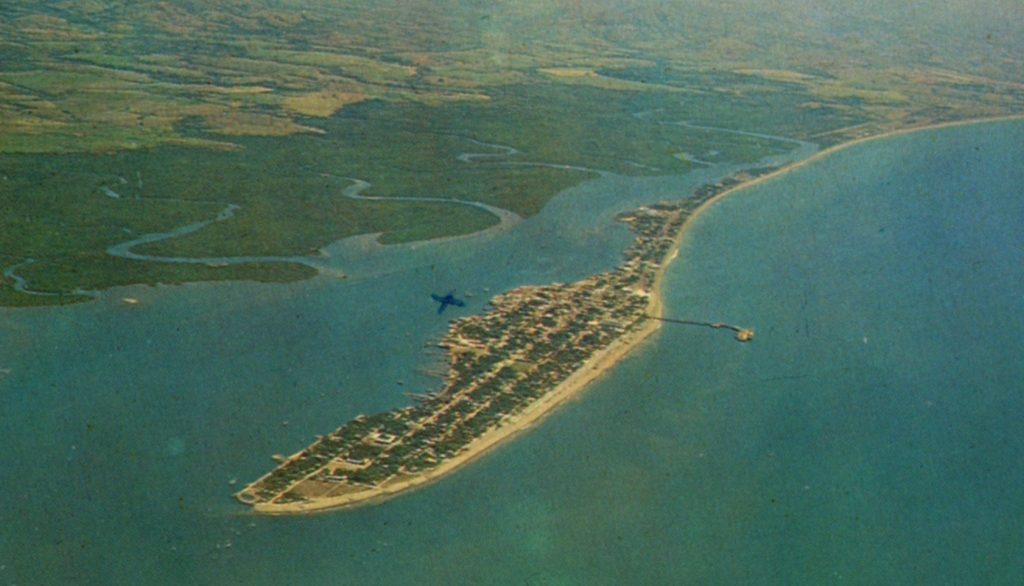 We had originally intended to call into some bays at the west end of the country, but the Papagayo had prevented us laying a course towards them, so we sailed directly on towards the main port on the Pacific coast of Costa Rica, Puntarenas, in the Gulf of Nicoya. It was not really allowed, but we had decided to spend a little time in the small islands on the other (western) side of the gulf to relax after the passage. We settled into an anchorage by Cedros and Jesusita islands, just off heavy mangroves on the mainland and very well protected.
We had originally intended to call into some bays at the west end of the country, but the Papagayo had prevented us laying a course towards them, so we sailed directly on towards the main port on the Pacific coast of Costa Rica, Puntarenas, in the Gulf of Nicoya. It was not really allowed, but we had decided to spend a little time in the small islands on the other (western) side of the gulf to relax after the passage. We settled into an anchorage by Cedros and Jesusita islands, just off heavy mangroves on the mainland and very well protected.
After a couple of days tidying up the boat and exploring in the dinghy we decided it was time to get legal. We motored over to Puntarenas in light airs and anchored by the big shipping wharf, where the sea breeze was kicking up quite a chop. Puntarenas town lies on a narrow spit of land between the mainland and the Gulf of Nicoya, with protected anchorage in the channel of an estuary behind the spit. We had been told, wrongly as it turned out, that we had to anchor in front of the town near the shipping wharf for clearance; when we were told that we would have to pay $20 for a launch to take the officials out to the boat we declined, offering instead to ferry them out through the choppy waters in our tiny dinghy – at which the very hefty Port Captain immediately suggested we move round to the calm side of the town for their inspection! We were being hassled by a local man throughout these negotiations, demanding a fee for his assistance and more for piloting us round the spit and down to the anchorage. We declined it all; and the narrow channel round was plenty deep and, while not marked, was easy enough to navigate.
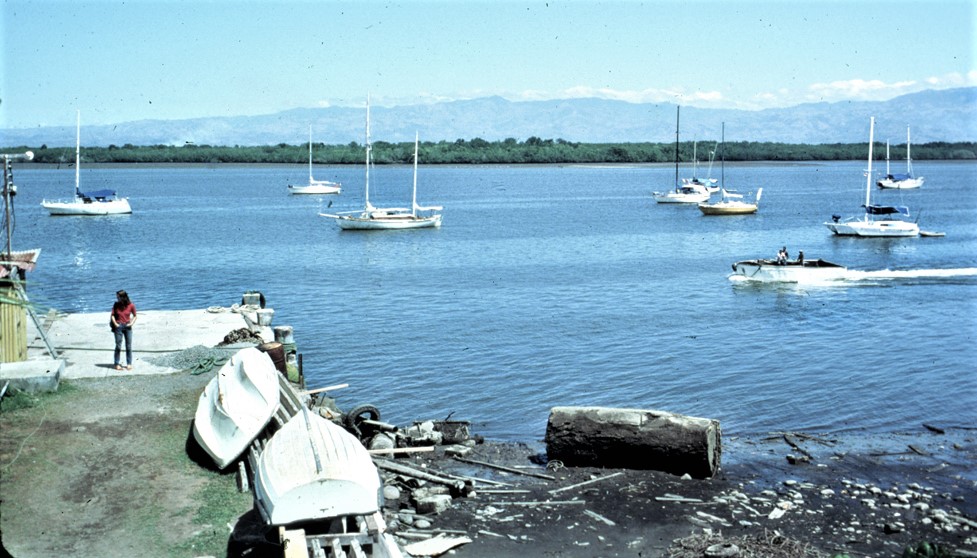 Once anchored (again) we ferried out no fewer than five officials for their various duties (Port Captain, Immigration, Customs, Agriculture and Narcotics), but all were friendly and drank very little of the whiskey we offered them. Only a small visa fee was charged. Ashore, we found a pleasant little town, with a good hardware store and less concentration on food and food shops than Mexico. Norma therefore found the market to be disappointing, with rather a sad selection of tired produce, in great contrast to the exciting abundance of Mexico. We never did find meat in Costa Rica which neared edibility. Mostly from Brahman cattle, it was as tough as old boots. But shop and stall-keepers were polite and friendly. There were orderly queues at the bank. The whole place was much cleaner than Mexico, and all bottles and containers were subject to a deposit, so none was lying around. We were beginning to find Costa Rica a lot more relaxing than Mexico!
Once anchored (again) we ferried out no fewer than five officials for their various duties (Port Captain, Immigration, Customs, Agriculture and Narcotics), but all were friendly and drank very little of the whiskey we offered them. Only a small visa fee was charged. Ashore, we found a pleasant little town, with a good hardware store and less concentration on food and food shops than Mexico. Norma therefore found the market to be disappointing, with rather a sad selection of tired produce, in great contrast to the exciting abundance of Mexico. We never did find meat in Costa Rica which neared edibility. Mostly from Brahman cattle, it was as tough as old boots. But shop and stall-keepers were polite and friendly. There were orderly queues at the bank. The whole place was much cleaner than Mexico, and all bottles and containers were subject to a deposit, so none was lying around. We were beginning to find Costa Rica a lot more relaxing than Mexico!
Back at the anchorage and meeting people from the other yachts, we caught up with all kinds of stories of adventure among those who had left Hualtulco with us. The big schooner had still not turned up and was reportedly low on fuel, water - and navigational skills! The US and local coastguards had been out searching. By the time it did finally arrive (at a different port) the incompetent skipper and crew, no longer on speaking terms, had decided to give up the whole enterprise (chartering in the Med and that) and were going back to Mexico! All the other yachts bar one 51-ft sloop arrived up to a week after us, and we heard all sorts of Conrad-like tales of high seas and suffering! This was the first time we had ever done a passage in any sort of company, and it was very interesting to experience our passage-making very differently from others who faced the same conditions.
 Norma was called into action for her sailmaking skills, patching up sails and even making sun hats like the ones we wore, and I caught up with some routine maintenance work on the engine, which had done a fair bit of duty on the way down the west coast. I was also called to see the Port Captain's assistant, who had been complaining about pain in his neck - nothing special. A young American had just opened a bar, showers, and whatnot at what he called the “Puntarenas Yacht Club”, a convenient and safe place to leave the dinghy. Costa Rica had a terrible reputation for theft, especially of dinghies and outboard motors, but now that everyone was taking all sorts of precautions the actual incidence of such events seemed to be low.
Norma was called into action for her sailmaking skills, patching up sails and even making sun hats like the ones we wore, and I caught up with some routine maintenance work on the engine, which had done a fair bit of duty on the way down the west coast. I was also called to see the Port Captain's assistant, who had been complaining about pain in his neck - nothing special. A young American had just opened a bar, showers, and whatnot at what he called the “Puntarenas Yacht Club”, a convenient and safe place to leave the dinghy. Costa Rica had a terrible reputation for theft, especially of dinghies and outboard motors, but now that everyone was taking all sorts of precautions the actual incidence of such events seemed to be low.
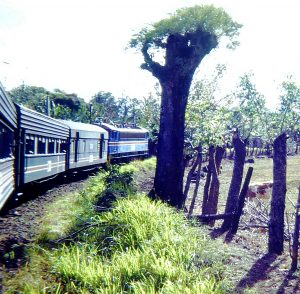
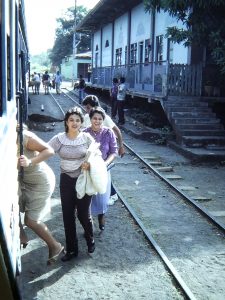 After five days we got up early for the six o'clock train trip to the capital city, San Jose, in a famous rickety narrow-gauge operation. This meandered through the mountains from hamlet to hamlet, for the inhabitants of which the train was the main mode of transport – their houses and shops even faced the railway line and the train stopped at every settlement. Through the open-air windows we could land so lush that the fence posts were sprouting – we had never seen miles of live and maintenance-free fences before. San Jose must be the cleanest city in Central America, with the National Theatre being a particularly fascinating building, a compact version of a “typical” baroque opera house of Milan or Paris, built by the banana aristocracy around the turn of the century. We had a good lunch served by white-coated waiters and then visited the National Museum. We returned by bus, viewing a different route and scenery, less remote, more sugar plantations.
After five days we got up early for the six o'clock train trip to the capital city, San Jose, in a famous rickety narrow-gauge operation. This meandered through the mountains from hamlet to hamlet, for the inhabitants of which the train was the main mode of transport – their houses and shops even faced the railway line and the train stopped at every settlement. Through the open-air windows we could land so lush that the fence posts were sprouting – we had never seen miles of live and maintenance-free fences before. San Jose must be the cleanest city in Central America, with the National Theatre being a particularly fascinating building, a compact version of a “typical” baroque opera house of Milan or Paris, built by the banana aristocracy around the turn of the century. We had a good lunch served by white-coated waiters and then visited the National Museum. We returned by bus, viewing a different route and scenery, less remote, more sugar plantations.
 Costa Rica was an amazing contrast to Mexico, and we had to keep reminding ourselves that Central America is a collection of separate countries with different histories and cultural background. Nevertheless, the malign influence of the original Spanish invaders is all-prevalent. Because Cortez and his ilk couldn’t find much in the way of gold in what became known as Costa Rica - the rich coast - it wasn’t heavily settled by Spaniards. The indigenous "Indians" suffered terribly, and their population decreased. So, the country's settlers have come from all over, and in recent times the policy had been of determined neutrality as far as the turmoil of the region is concerned. The country does not have a standing army, and the money freed by the lack of a defence budget goes generally to education, so that the standard of literacy is higher than average in the region.
Costa Rica was an amazing contrast to Mexico, and we had to keep reminding ourselves that Central America is a collection of separate countries with different histories and cultural background. Nevertheless, the malign influence of the original Spanish invaders is all-prevalent. Because Cortez and his ilk couldn’t find much in the way of gold in what became known as Costa Rica - the rich coast - it wasn’t heavily settled by Spaniards. The indigenous "Indians" suffered terribly, and their population decreased. So, the country's settlers have come from all over, and in recent times the policy had been of determined neutrality as far as the turmoil of the region is concerned. The country does not have a standing army, and the money freed by the lack of a defence budget goes generally to education, so that the standard of literacy is higher than average in the region.
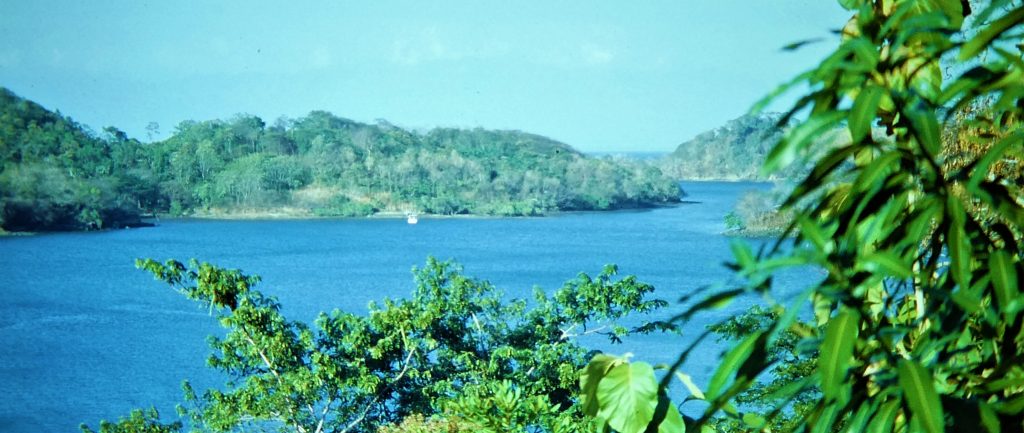 We had a very enjoyable week in the estuary, but we then sailed back across the Gulf of Nicoya from Puntarenas to the pretty collection of little islands with calm and protected anchorages we had visited on the way in. We spent a couple of nights anchored off the tiny Isla Pajaros and dinghied across to a bay on the mainland to catch up with some people we had met at one of the San Diego yacht clubs. On the mainland we also met Curt, an American expat, who owned a lovely property adjacent to a large older one, Hacienda Nicoya (a social centre for yachties and expats). Curt was very anxious to sell his property, with orchard and adequate house, for as little as $15-20,000, but with no takers. He was caught in a trap like many other expats in Central America: retired to an idyllic property with a lovely lifestyle, but now growing old and without sufficient money even to get back to his family in north-west USA. We then returned to Jesusita and spent some time at a little resort there, the only one, getting friendly with the managers and assorted gringo visitors.
We had a very enjoyable week in the estuary, but we then sailed back across the Gulf of Nicoya from Puntarenas to the pretty collection of little islands with calm and protected anchorages we had visited on the way in. We spent a couple of nights anchored off the tiny Isla Pajaros and dinghied across to a bay on the mainland to catch up with some people we had met at one of the San Diego yacht clubs. On the mainland we also met Curt, an American expat, who owned a lovely property adjacent to a large older one, Hacienda Nicoya (a social centre for yachties and expats). Curt was very anxious to sell his property, with orchard and adequate house, for as little as $15-20,000, but with no takers. He was caught in a trap like many other expats in Central America: retired to an idyllic property with a lovely lifestyle, but now growing old and without sufficient money even to get back to his family in north-west USA. We then returned to Jesusita and spent some time at a little resort there, the only one, getting friendly with the managers and assorted gringo visitors.
At night we were entertained by the screams of the howler monkeys in the trees of the coastal jungle, but we never saw one.
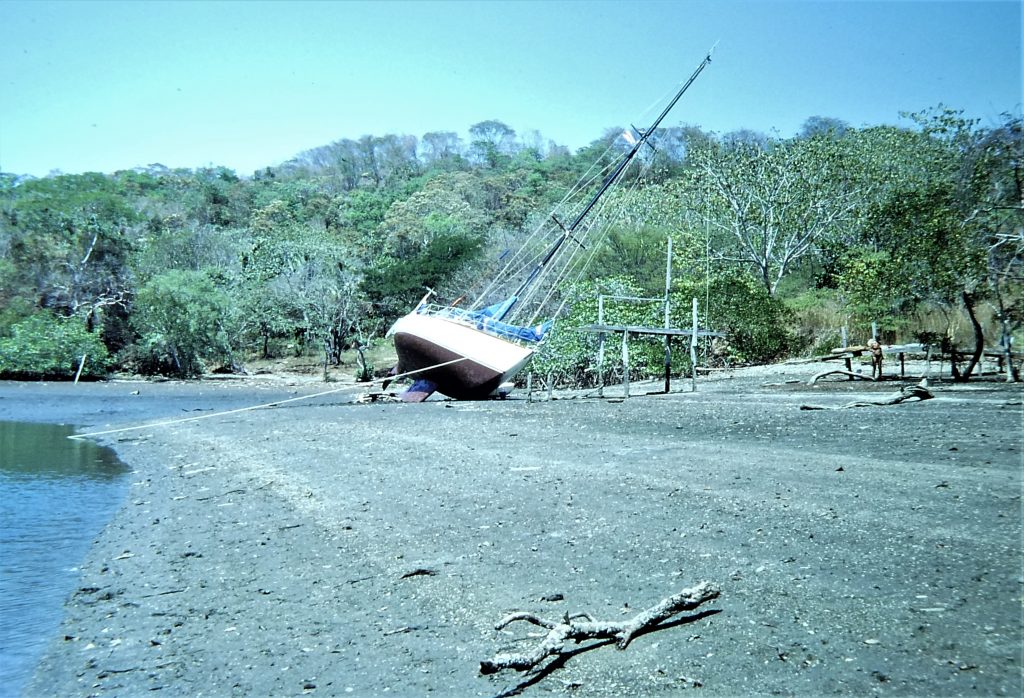 We returned to Puntarenas for boat maintenance and shopping, and cleared Customs etc for Golfito and "Puertos Intermedios". But the next step was to yet again return to Jesusita to clean and antifoul the bottom of the boat. The tidal range in the Gulf is around four metres at springs, and we had decided to careen the boat on a fairly steep beach we had identified as suitable when here before. We anchored fore and aft close to the beach and took a line ashore from the masthead to ensure that we tilted the right way when the tide retreated. It all went very well. We scrubbed, sanded and painted the starboard side with very sludgy Mexican antifouling paint ("muy toxico", we had been assured). Peter Joubert, the designer, had assured us that the boat would float and come upright without letting any water in, but we were sort of relieved when it did exactly what was promised! The next day, having turned her round, we did it all again for the port side. It had all gone well, we thought, and we were rather pleased with ourselves for using such a traditional method for the task.
We returned to Puntarenas for boat maintenance and shopping, and cleared Customs etc for Golfito and "Puertos Intermedios". But the next step was to yet again return to Jesusita to clean and antifoul the bottom of the boat. The tidal range in the Gulf is around four metres at springs, and we had decided to careen the boat on a fairly steep beach we had identified as suitable when here before. We anchored fore and aft close to the beach and took a line ashore from the masthead to ensure that we tilted the right way when the tide retreated. It all went very well. We scrubbed, sanded and painted the starboard side with very sludgy Mexican antifouling paint ("muy toxico", we had been assured). Peter Joubert, the designer, had assured us that the boat would float and come upright without letting any water in, but we were sort of relieved when it did exactly what was promised! The next day, having turned her round, we did it all again for the port side. It had all gone well, we thought, and we were rather pleased with ourselves for using such a traditional method for the task.
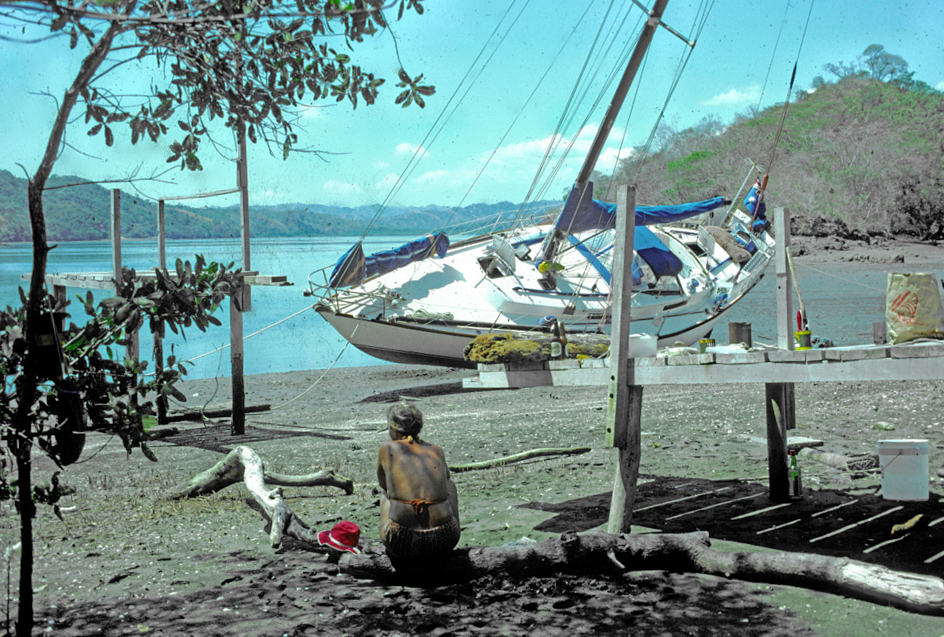 After three days' rest, with our newly clean bottom we sailed for two full days to the other main port for yachts on the Pacific coast, Golfito. It was a slow trip in little wind, threatened by thunder and lightning. Golfito is a nearly completely landlocked bay, with an eponymous town at its northern head, lying on the east side of a bigger bay, the Golfo Dulce.
After three days' rest, with our newly clean bottom we sailed for two full days to the other main port for yachts on the Pacific coast, Golfito. It was a slow trip in little wind, threatened by thunder and lightning. Golfito is a nearly completely landlocked bay, with an eponymous town at its northern head, lying on the east side of a bigger bay, the Golfo Dulce.
Golfito ("little gulf") is normally pretty easy to enter, once the entrance is identified among the dense forests along the coast, but during our final approach to the narrow entrance the developing sea breeze combined with a vicious squall and a pall of driving rain. In poor visibility we had to grope in with especial care, easing about half way up the bay to seek the best shelter and finally dropping anchor off what we presumed to be a hotel we had read about. There were a handful of yachts there, so we couldn’t be far wrong, we thought.
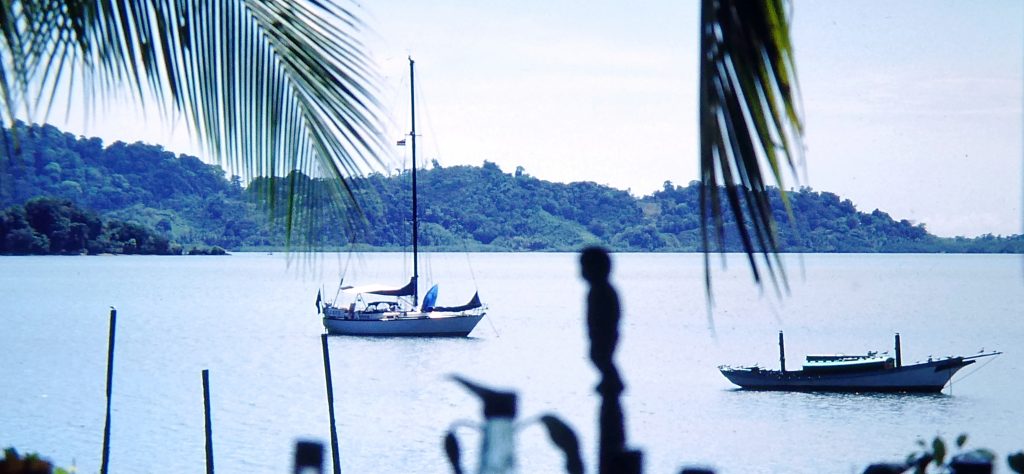 The hotel it turned out to be, once the rain stopped, was the Hotel Miramar, run with friendly concern for the needs of passing yachts by a cruising American couple with a temporarily dropped hook. The other anchorage in the bay, we were to find, was overseen by another expatriot, “Captain Tom”, a one-legged ex-US marine who will fix hamburgers for those who like them, and who has rigged up a rudimentary shower and laundry.
The hotel it turned out to be, once the rain stopped, was the Hotel Miramar, run with friendly concern for the needs of passing yachts by a cruising American couple with a temporarily dropped hook. The other anchorage in the bay, we were to find, was overseen by another expatriot, “Captain Tom”, a one-legged ex-US marine who will fix hamburgers for those who like them, and who has rigged up a rudimentary shower and laundry.
We walked in hot, humid and sweaty conditions into the town, to clear in with the officials, as in all of Central America. Here, the Port Captain was the immigration man and was also the Yanmar agent, whose sign was what we were told to look for, and who said “perfectamente” when I dealt out the array of ship’s papers. No problems. Nice man.
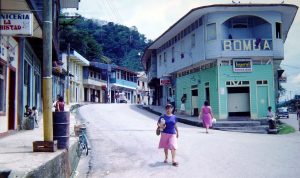 Golfito is the archetypal Central American banana port. It looked a bit "wild-western" to us, with very simple shops but much better produce than in Puntarenas. There are a few general stores, and a weekly market – a good one, with fresh produce from lush, rain-soaked fields. But most of the doors along the main street open into cantinas, spilling Latin American disco sounds and the occasional drunk into the street. Few men are regularly employed. The cantina is a place to go, cerveza is not that expensive, and what the hell, it’s hot.
Golfito is the archetypal Central American banana port. It looked a bit "wild-western" to us, with very simple shops but much better produce than in Puntarenas. There are a few general stores, and a weekly market – a good one, with fresh produce from lush, rain-soaked fields. But most of the doors along the main street open into cantinas, spilling Latin American disco sounds and the occasional drunk into the street. Few men are regularly employed. The cantina is a place to go, cerveza is not that expensive, and what the hell, it’s hot.
The people, too, were more outgoing than in Puntarenas.
However, the banana business had recently collapsed because of the march through Central American of the fungal Panama Disease, so at this time only an occasional ship was pulling in to the big commercial wharf. The school and box-like houses of the banana company “new town” looked grey and lonely, the business kept ticking over by a few managers and supervisors.
Thus, the depressed banana economy has hit the local people hard. There was a variety of cultures apparent to us, the reason being the inflows of immigrants for the original banana business.Their forebears were imported from many countries in the boom days of fruit, and at this time the uniquely polyglot culture has little to look forward to. Theft from yachts, unfortunately, is a side effect, and from the Hotel Miramar a floodlight shone reassuringly on those that were anchored a few yards offshore and easily seen from the open-fronted bar. Cool cervezas and the friendly macaws remain happy memories, although the latter lost some tail feathers to Norma’s Pacific-island-style trolling lures.
The common man and his family live mostly in the old town, their dwellings decaying, sagging, those at the waterfront slipping slowly into the muddy bay. To avoid the worst of the bugs, small communities build on stilts over the water, and smoke drifts lazily over the rickety roofs as the tide carries garbage away from underneath.
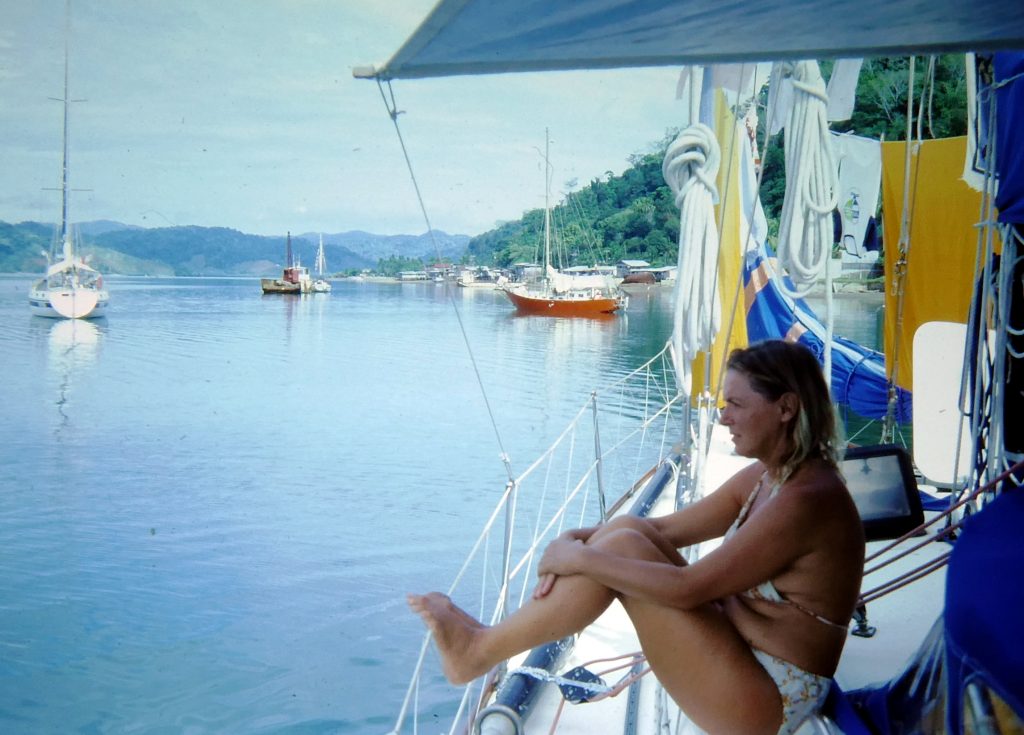 As usual, the boat people became friends. The amazing catamaran, “Taurua“, had been built in an English woodland by Wayland and Aruna using wholly traditional methods. They had steam-bent the frames from staves cleaved from raw wood (no saws were used at all), and the hulls were skinned by layers of tarred paper. Lying downwind of Taurua, our noses reminded us of recently-surfaced highways. On their own smithy, they had forged all the yacht’s iron work; the cartwheel around which the frames had been bent lay on the foredeck, and a full-sized anvil and all blacksmithing tools were tucked away below. Aloft, their tiny baby girl - who had been born on a beach in Panama - climbed what little rigging was needed to support their timber mast and the wing sail which, when set, enclosed it. This patented sail was entirely of Wayland’s design, built around flexible formers which settle automatically into the aerofoil shape which is most appropriate for the chosen tack.
As usual, the boat people became friends. The amazing catamaran, “Taurua“, had been built in an English woodland by Wayland and Aruna using wholly traditional methods. They had steam-bent the frames from staves cleaved from raw wood (no saws were used at all), and the hulls were skinned by layers of tarred paper. Lying downwind of Taurua, our noses reminded us of recently-surfaced highways. On their own smithy, they had forged all the yacht’s iron work; the cartwheel around which the frames had been bent lay on the foredeck, and a full-sized anvil and all blacksmithing tools were tucked away below. Aloft, their tiny baby girl - who had been born on a beach in Panama - climbed what little rigging was needed to support their timber mast and the wing sail which, when set, enclosed it. This patented sail was entirely of Wayland’s design, built around flexible formers which settle automatically into the aerofoil shape which is most appropriate for the chosen tack.
Wayland and Aruna had made a film of this fascinating project, which they showed at the banana company’s meeting hall after advertising the performance around town. The audience were mostly American company managers and the yacht people, but Wayland had rehearsed a Spanish commentary which, undaunted, he proceeded to give in an English accent so broad that the few Spanish speakers in the audience couldn’t understand it either.
The other filmmakers in the anchorage were Daniel and Magi, from Belgium in their beautiful aluminium sloop Elais, which they had also built themselves. Daniel is a pro, and the film showing the first part of the story of their voyage had just been shown on Belgium television. They also wanted to show it in Golfito – but the commentary was in French. Norma speaks French.
“Can you help me, just for a few minutes?”, says Daniel. “My English is not so good. Please help me say an English introduction”. Two days later, Norma had translated the entire, half-hour commentary, and I had recorded a completely new voice-over in English in a blacked-out spare room at the back of the Hotel Miramar. The premiere of this version was finally received with great acclaim by the bar-side audience.
Among those who were employed in Golfito were the local anti-drug squad, enthusiastically searching yachts after training in the United States. One yacht was searched each day. But we were away from Cera a lot, walking in the forest and taking bus trips to other villages. So it was that one day Daniel said, “the drug squad keep coming to search your boat, but you’re never there. Can you tell them when you will be, please?” The very next day a speedboat pulled alongside our dinghy as we were returning from the town, and we were politely asked, were we from Cera and were we going to the boat? We were, indeed. So, duly surprised by this unexpected honour we welcomed aboard the chief drugs man (his number two was in disgrace for cadging cassette tapes off the other yachts, and wasn’t allowed aboard), who did his search and pronounced us clean.
A necessary bus ride was to Cuidad Neilly, the regional centre, to obtain Panamanian visas from the consul. Not a bad bus ride, for Central America, in not a bad bus, through green forests and plantations of palm oil and bananas, fields of contented white cows surrounded by contented white birds. But the Panamanian consul was grumpy. Twenty dolares for us two. "American dolares solamente“. Fortunately, we had some.
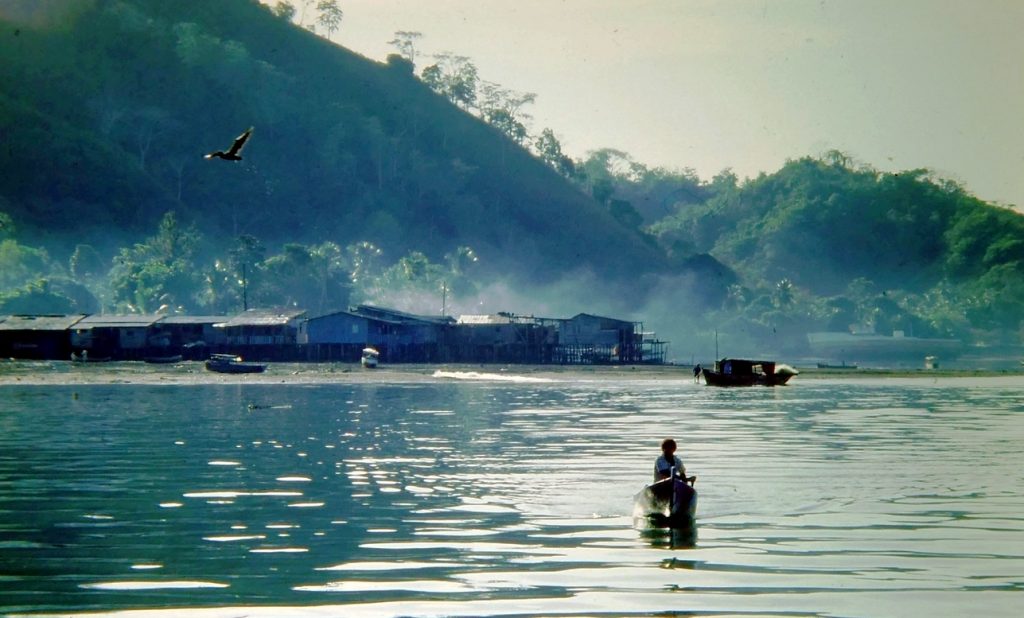 There are not a lot of places where you can see an iguana climbing on a yacht. During one of the regular afternoon rain storms (which explained the lushness of the thick, jungly vegetation on the hills overlooking us), Norma and I stared with bemused amazement as a large example of the species swam determinedly out to us. “Do iguanas swim?”, I asked. “Well that one does”.
There are not a lot of places where you can see an iguana climbing on a yacht. During one of the regular afternoon rain storms (which explained the lushness of the thick, jungly vegetation on the hills overlooking us), Norma and I stared with bemused amazement as a large example of the species swam determinedly out to us. “Do iguanas swim?”, I asked. “Well that one does”.
Reaching Cera it scrabbled for a foothold on our quarter. Norma had successfully beaten off an attack by a swimming cockroach in Hawaii with the boat hook, but before again reach for this defensive weapon our potential boarder gave up. But only on us; a few yards away lay the British catamaran, ripe for a renewed assault. Now, as noted above, the skin of this particular cat was made of tarred paper. And tarred paper is something an iguana can get its claws into, so with great success the spiky reptile scaled the heights of the port hull. “Hey, Aruna!” we yelled. “There’s an iguana on your boat!”
This surreal scene seemed right somehow, for the place where we lay. The heat draws steam from the jungle, which looms over Golfito and surrounds Golfo Dulce, the landlocked bay in which we lay Anything, we felt, in this lazy, humid, eery atmosphere, could happen. Like iguanas climbing on to paper boats.
Just over a week in the bay we were sad to clear out of magical Golfito, with its unforgettable memories. We had the usual Central American runaround, of course: from port captain to municipal tax office to port captain to bank to customs to port captain, three hours total, not bad really. But it was very hot.
[Another contemporary footnote: as for Huatulco in Mexico, we can see from photographs that things have changed enormously in the 36 years since we visited Golfito. It has become a major tourist resort, with generally low-level development along the shores and several new marinas catering for megayachts. We hope that the obvious prosperity has made its way to the local people. Looking back over the decades, we are so pleased that we were able to enjoy visiting such places before modernity brought about such changes.]
The Pacific coast of Panama
The original plan, emerging during the building of our yacht, was that we would sail up to the Pacific Northwest, then down the west coast of the north American continent to California, then return to Australia via French Polynesia and the western South Pacific - a big loop around the Pacific half of the world, in other words.
However, by the time we were actually sailing down the west coast, we had come to the decision to continue east through the Panama Canal to the Caribbean, and later decide whether to continue east and cross the Atlantic Ocean. The finances were holding up - helped by the very low cost of living in Central America - and we were still having a wonderful time.
We knew little about the coast of Panama, which we would transit on our way to the Canal, and there was little written about the coast as a cruising ground. However, the advice from sailors who had been there, mostly Americans we had met in Costa Rica, was that it was a lovely coast to explore. Indeed, rather to our surprise the next three weeks did indeed provide some of the most attractive and interesting sailing since the Pacific Northwest. Between the border with Costa Rica and the massive peninsula which borders the west side of the Gulf of Panama lies the very long and wide Gulf of Chiriqui, within which lie several groups of small, very sparsely inhabited islands, and along the shores of which are numerous river estuaries and protected bays.
 So, after leaving Golfito we turned south-east, rounded Punta Burica in Panama, and sailed up towards Chiriqui and our first stop, at the Isla Parida. We anchored by ourselves in a sandy bay on the east side, to catch the sea breeze - it was very hot by then, and the first task was to set the sun awning and the wind scoop over the forward hatch. The log records that we savoured the perfumed smell of the Central American jungle. There were just a few huts behind the beach. The seawards view was of a multitude of small islands. The water was a little murky, but but a major river system drained through a muddy inlet on the mainland to our north, the Bahia de los Muertos. To our relief, the period of dusk when the flies and mosquitos emerged was only brief, and we dined in the cockpit and did not need screens overnight.
So, after leaving Golfito we turned south-east, rounded Punta Burica in Panama, and sailed up towards Chiriqui and our first stop, at the Isla Parida. We anchored by ourselves in a sandy bay on the east side, to catch the sea breeze - it was very hot by then, and the first task was to set the sun awning and the wind scoop over the forward hatch. The log records that we savoured the perfumed smell of the Central American jungle. There were just a few huts behind the beach. The seawards view was of a multitude of small islands. The water was a little murky, but but a major river system drained through a muddy inlet on the mainland to our north, the Bahia de los Muertos. To our relief, the period of dusk when the flies and mosquitos emerged was only brief, and we dined in the cockpit and did not need screens overnight.
The next morning some local people paddled by in their dugout canoe, and we invited them aboard for a chat and a drink. We asked them how often they saw yachts, and they told us that we were the first for six months - which they seemed to regard as quite often! We then moved over to an adjacent little island, Isla Gomez, with a lovely outlook, and were visited by another member of the family we had had aboard. He brought four small lobsters, pawpaws and bananas, and promised us more for tomorrow. We were then joined by another boat, sailing single-handed by an American chef. We zoomed round some nearby islets in his fast inflatable.
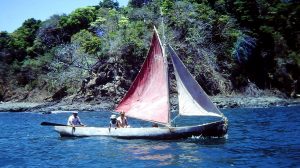 We then continued to wander from island to bay to island, including the Islas Secas and Islas Contreras. At Isla Brincancon we found a splendid anchorage in a bay on its northern shore, where the water was clear and the fishing good. A couple more yachts turned up - crowded! All were sailing for the South Pacific, so we spent much time describing the places we had visited there. Ashore, the jungle grew right down to the beach, but there were a few trails along which we could walk through the amazing variety of trees, from red ironwood to soft balsa. Lots of birds sang pretty songs.
We then continued to wander from island to bay to island, including the Islas Secas and Islas Contreras. At Isla Brincancon we found a splendid anchorage in a bay on its northern shore, where the water was clear and the fishing good. A couple more yachts turned up - crowded! All were sailing for the South Pacific, so we spent much time describing the places we had visited there. Ashore, the jungle grew right down to the beach, but there were a few trails along which we could walk through the amazing variety of trees, from red ironwood to soft balsa. Lots of birds sang pretty songs.
We also sailed over to a bay in the mainland, the Ensenada Rosario. It was still mostly jungle all round, but there were a couple of family settlements and a fair bit of cultivation of the land. Norma approached a local man, but he hid shyly away. Back aboard, we caught a baby hammerhead shark, delicious when fried for dinner. The next big bay down was the well-protected and attractive Bahia Honda, where we anchored in a little bay with a beach, so Norma went straight ashore. The air was becoming quite smoky by the time, especially on the mainland, the result of the slash-and-burn cultivation.
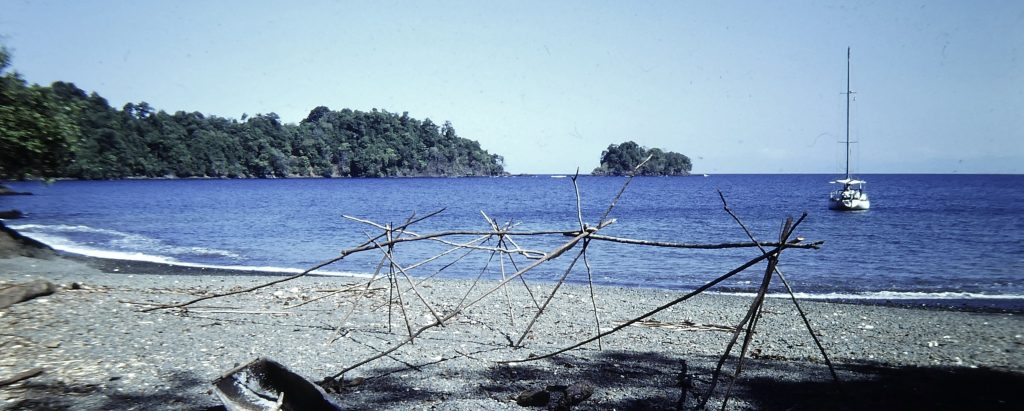 There was a small island with a village in the centre of the Bahia Honda. With no use for cash money, the shy people here and elsewhere along the coast traded lobsters, fish, fruit, vegetables and artefacts for tins of soup, fish hooks, and line, and small bottles of liquor. This is really a forgotten part of the world, as most boats on passage along the coast the coast sail right by, on their way to the Canal. We loved it.
There was a small island with a village in the centre of the Bahia Honda. With no use for cash money, the shy people here and elsewhere along the coast traded lobsters, fish, fruit, vegetables and artefacts for tins of soup, fish hooks, and line, and small bottles of liquor. This is really a forgotten part of the world, as most boats on passage along the coast the coast sail right by, on their way to the Canal. We loved it.
Finally, we had to make serious sail and press on down to the Gulf of Panama. We left in calm conditions, but by early next day the wind had picked up. The last point of land before rounding into the Gulf of Panama is most aptly named Punta Mala (”bad”), because the current-ridden waters are churned into a turmoil by the strong east and north-east winds which almost always blow here. To make the Canal direct would have been a dead beat into the prevailing north-east wind, and to lay off for the Pearl Islands gave us a better slant. Even so, we had a very hard time of it for a while, as did most others we know. One old schooner was dismasted and, with engine trouble, drifted off miles to the south; the bill for her rescue and towing to Balboa came to $18,000.
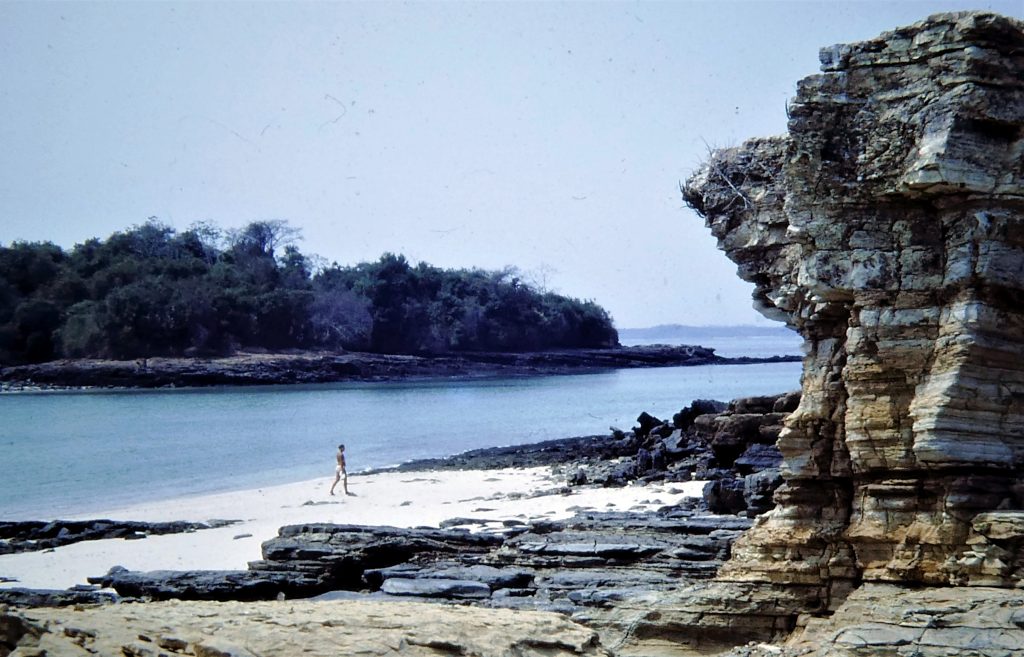 Having passed that gateway to the gulf, in calmer weather we motored up to the Archipielago de las Perlas, the Pearl Islands, where we were to spend a pleasant week. These are about 50 miles south-east of Panama City, with many anchorages popular with boats heading from and going to the Canal. The islands were named by Balboa, who was impressed by the massive pearls used by the islanders. One of the biggest, “La Peregrina”, was in the hands of Spanish royalty for centuries and was now owned by Elizabeth Taylor. But the pearls are long gone from the islands now.
Having passed that gateway to the gulf, in calmer weather we motored up to the Archipielago de las Perlas, the Pearl Islands, where we were to spend a pleasant week. These are about 50 miles south-east of Panama City, with many anchorages popular with boats heading from and going to the Canal. The islands were named by Balboa, who was impressed by the massive pearls used by the islanders. One of the biggest, “La Peregrina”, was in the hands of Spanish royalty for centuries and was now owned by Elizabeth Taylor. But the pearls are long gone from the islands now.
After passing through some rather exposed-looking outer islands we anchored off a village on the island of Pedro Gonzalez. Hardly was the anchor set when we were approached by a couple of men offering "Panama roja", the local pot. We had been warned about that. Another pair of kids kids came over in a dugout, wanting anything going.
The village did not look inspiring, the anchorage was a bit scruffy with floating rubbish, and we were faced by the prospect of a constant line of canoes with locals wanting stuff, so the next morning we went on and into a gorgeous anchorage between 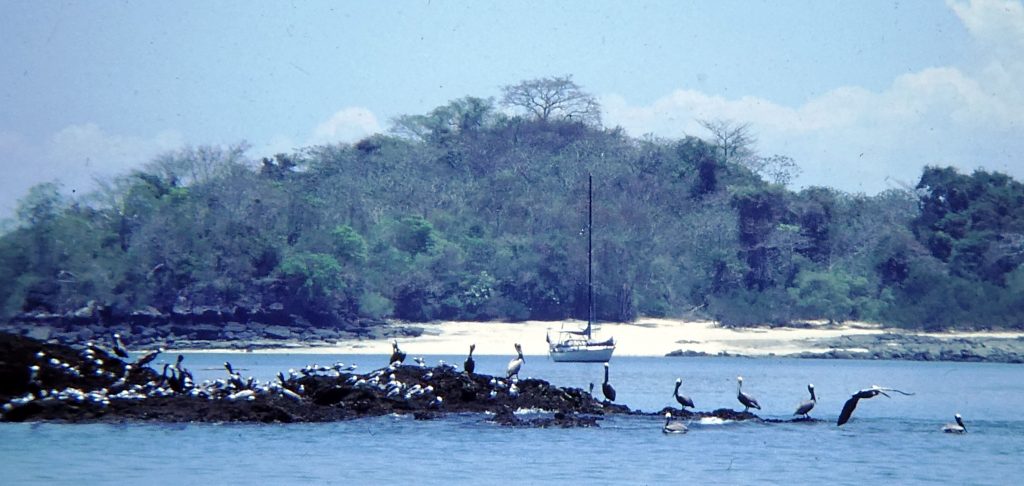 Bayonata and la Vivienda islands. It had a pretty beach, so Norma went ashore as soon as possible. There were lots of rocks and islets all around, clearly exposed when the seven-metre tide was low and the whole aspect changed. Birds were everywhere, pelicans diving and flying in formation. Facing south towards open waters it was a little rolly at night, so we moved round to a totally protected little bay on the north side of Bayonata - a beautiful, calm haven.
Bayonata and la Vivienda islands. It had a pretty beach, so Norma went ashore as soon as possible. There were lots of rocks and islets all around, clearly exposed when the seven-metre tide was low and the whole aspect changed. Birds were everywhere, pelicans diving and flying in formation. Facing south towards open waters it was a little rolly at night, so we moved round to a totally protected little bay on the north side of Bayonata - a beautiful, calm haven.
Around the several nearby islets in the dinghy we picked up several branches of black coral and many shells for Norma's collection. Trolling a line from the dinghy Norma caught as much fish as we could eat. The water was very cold, because a finger of the cold Humboldt current coming from Colombia, was hooking up into the Gulf of Panama. This was bringing lots of fish, and therefore the masses and masses of birds.
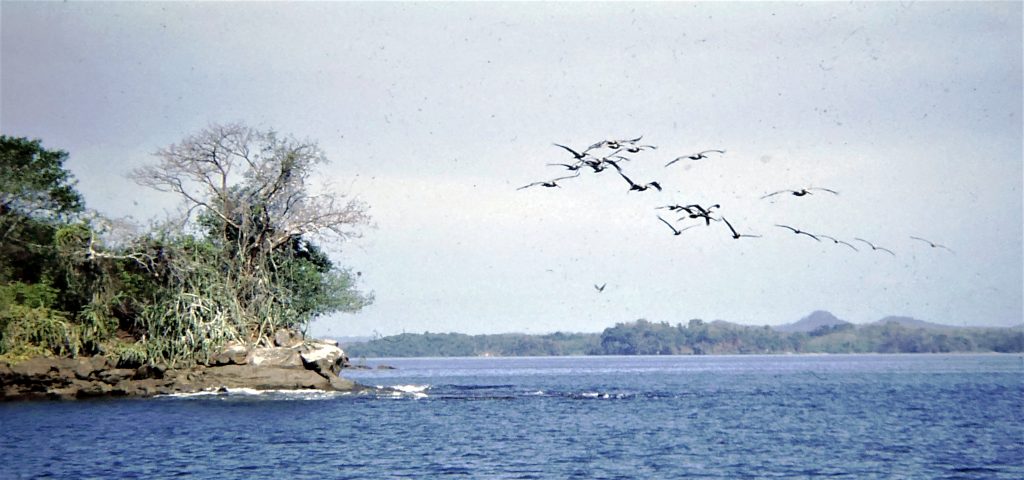 We had many more happy, peaceful days in the Pearl Islands. Piloting needed care; when we were there, in March, the equinoctial spring tide range exceeded seven metres, and the whole area is a thick mass of rocks. The local charts were unreliable and of too large a scale to show any detail. So we only moved at low tide, and did avoid ending up high and dry. We meandered north, passing Casayeta and Mogo Mogo islands and coming to anchor off a long beach on the south-east side of Contadora Island. This is the most developed island, complete with a casino and some shops. The Shah of Iran spent his early weeks of exile here, and foreign ministers of some Latin American countries met to form the Contadora Group. The fishing was still excellent, although we were still catching plenty of fish and didn't need much by way of food.
We had many more happy, peaceful days in the Pearl Islands. Piloting needed care; when we were there, in March, the equinoctial spring tide range exceeded seven metres, and the whole area is a thick mass of rocks. The local charts were unreliable and of too large a scale to show any detail. So we only moved at low tide, and did avoid ending up high and dry. We meandered north, passing Casayeta and Mogo Mogo islands and coming to anchor off a long beach on the south-east side of Contadora Island. This is the most developed island, complete with a casino and some shops. The Shah of Iran spent his early weeks of exile here, and foreign ministers of some Latin American countries met to form the Contadora Group. The fishing was still excellent, although we were still catching plenty of fish and didn't need much by way of food.
It wasn't a particularly good anchorage, though, and after one night we set sail for Taboga island, at the head of the Gulf of Panama and a jumping-off stop for our passage through the Canal. The Gulf of Panama teems with fish, and the sea came alive with wonderful specimens. We caught dorado after dorado and the occasional tuna, as many as we could handle. All were destined for Norma's bottling preservation and storage.
The Panama Canal
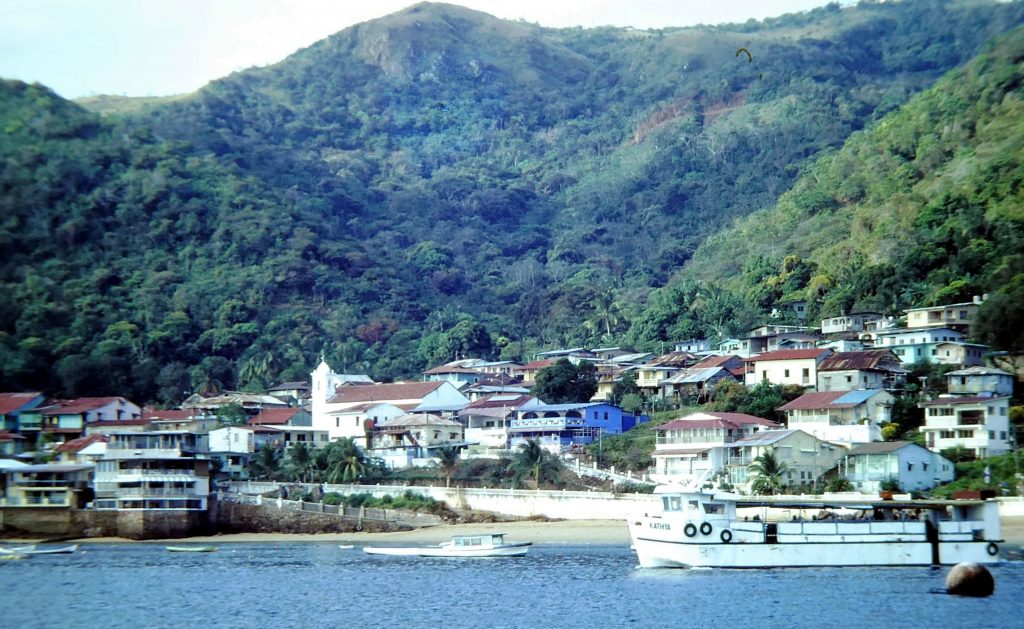 Taboga Island is close to Panama City and the Pacific end of the Canal. We spent but one night there, joining some crew from a couple of charter yachts on delivery trips for dinner at a hotel ashore. The little town and the anchorage were pleasant, but we were anxious to get going for the great Canal adventure, so motored over to a mooring off the Balboa Yacht Club. We cleared Customs with a dozy man at the end of the yacht club wharf and paid rip-off fees at the club for using one of their moorings - no choice, as we were not allowed to anchor anywhere. In any event we still had to organise fuel, crew, a pilot getting the official measurement done and other administrative tasks completed.
Taboga Island is close to Panama City and the Pacific end of the Canal. We spent but one night there, joining some crew from a couple of charter yachts on delivery trips for dinner at a hotel ashore. The little town and the anchorage were pleasant, but we were anxious to get going for the great Canal adventure, so motored over to a mooring off the Balboa Yacht Club. We cleared Customs with a dozy man at the end of the yacht club wharf and paid rip-off fees at the club for using one of their moorings - no choice, as we were not allowed to anchor anywhere. In any event we still had to organise fuel, crew, a pilot getting the official measurement done and other administrative tasks completed.
Cera was "admeasured" for the transit by a very nice American lady, Eva, who also measured an American yacht with whose owners, Al and Sharon Baker we had eaten out last night and with whom we agreed to trade line-handling through the Canal. Eva took us into town and the Marine Traffic Control Center for transit arrangements At the time these arrangements were an American operation, but we also had to go and see the Panamanian Port Captain for clearance. This was something of a contrasting experience, as we faced the Central American bureaucracy in full flight again. With that all done we took a bus into Balboa and bought a new camera and a watch from one of the many duty-free shops. Back at the BYC we fixed up with two young Australian men to fill our compulsory complement of line-handlers.
After another day getting ready with long lines, fenders and the like, and getting permission from Immigration officials to go from Balboa to Colon at the other end of the Canal, in the morning of 29 March 1984 we set off to cross the Isthmus of Panama from the Pacific to the Atlantic Ocean and a whole new phase of our adventure.
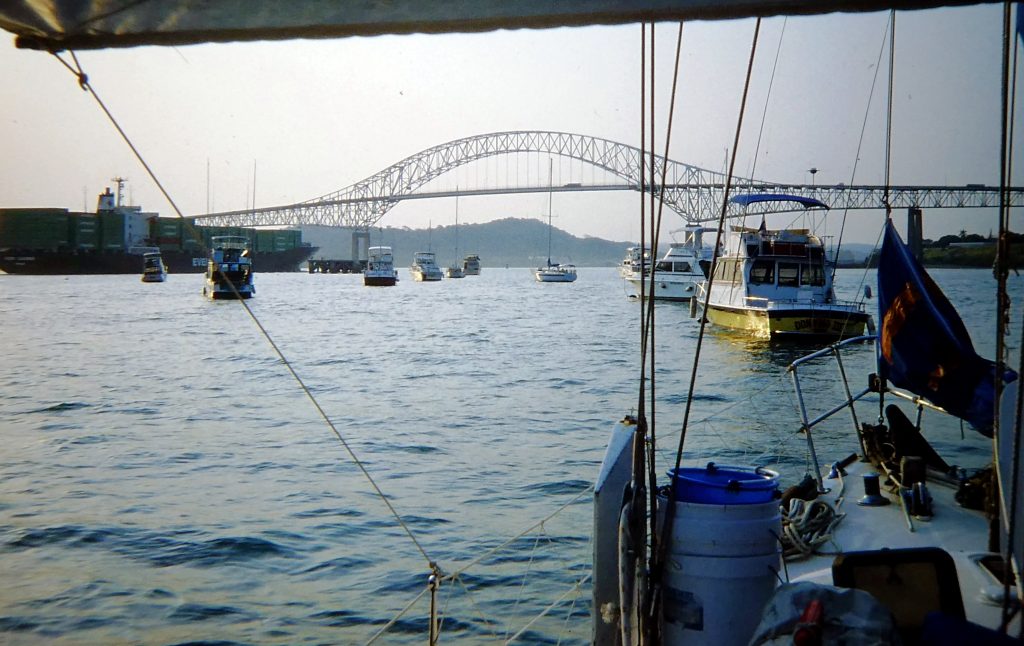
Read more: Panama to Ireland
